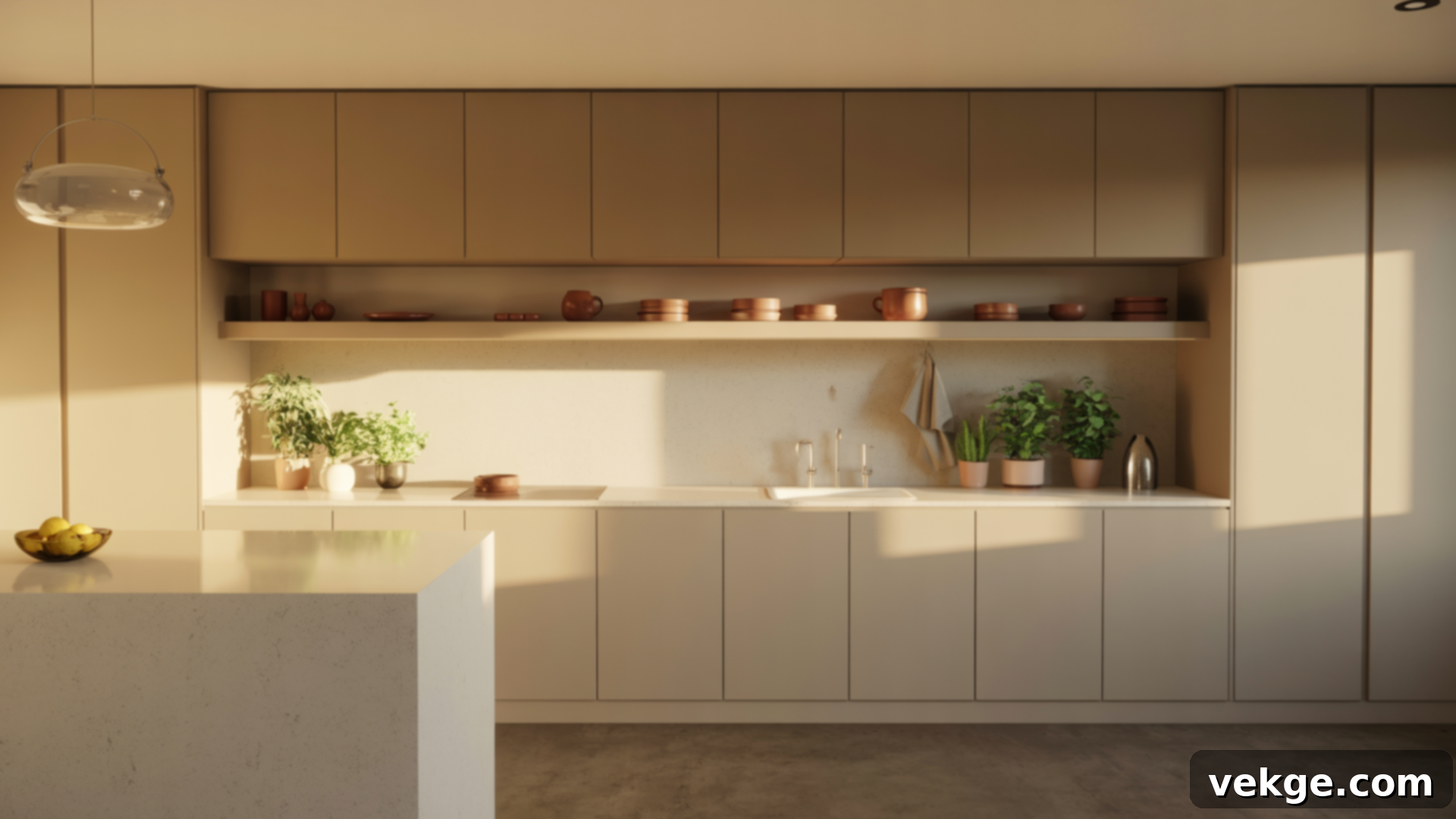The Ultimate Guide to a Minimalist Kitchen: Design Ideas for a Clutter-Free & Functional Space
Imagine stepping into your kitchen and instantly feeling a sense of calm. Every item has its place, countertops are clear, and the space feels effortlessly organized and efficient. This isn’t just a dream; it’s the reality a minimalist kitchen can offer. More than just an aesthetic, a minimalist kitchen is about creating a practical, calming, and highly functional environment that truly works for you and simplifies your daily life.
Many believe minimalism means sacrificing comfort or style, but the truth is quite the opposite. It’s about thoughtful design, quality over quantity, and maximizing efficiency without compromising on beauty. In this comprehensive guide, we’ll walk you through the core principles of simplifying your kitchen, making it incredibly functional, and ensuring it remains a beautiful, inviting space. By adopting these simple yet powerful approaches, you’ll discover how a minimalist kitchen can transform your daily routines, reduce stress, and even enhance your joy of cooking. Ready to design a kitchen that perfectly fits your needs and lifestyle? Let’s dive in!
What is a Minimalist Kitchen?
At its heart, a minimalist kitchen is a design philosophy centered around simplicity, intentionality, and maximum efficiency. It’s not merely about having less; it’s about having exactly what you need, where you need it, and nothing more. The primary goal is to strip away the superfluous, creating an environment that streamlines meal preparation, cooking, and cleaning processes. By eliminating unnecessary items and focusing on practicality, a minimalist kitchen fosters a sense of order and calm that enhances your entire culinary experience.
This design approach emphasizes streamlined appliances, simple, unobtrusive décor, and intelligent storage solutions, ensuring that every single element serves a clear purpose. The underlying philosophy is to cultivate a more organized, stress-free, and enjoyable environment. It moves beyond purely aesthetic considerations, aiming to make your kitchen perform better for you, reduce visual noise, and ultimately, make daily tasks feel effortless and more pleasurable. A truly minimalist kitchen is a harmonious blend of form and function, where every detail contributes to a serene and highly efficient space.
Key Elements of a Minimalist Kitchen
Achieving a truly minimalist kitchen relies on integrating several core elements that collectively promote simplicity, functionality, and a clean design aesthetic. These principles guide every decision, from layout to material choice, ensuring a cohesive and tranquil space:
- Clutter-Free Surfaces: This is arguably the most recognizable trait of a minimalist kitchen. Keeping countertops entirely clear of non-essential items creates a vast, open workspace that is not only visually appealing but also incredibly practical for cooking and exceptionally easy to clean. Everything from small appliances to decorative items should be stored out of sight when not in use, fostering a sense of calm and order.
- Neutral Color Palette: The choice of colors plays a pivotal role in creating a serene and timeless atmosphere. Opting for neutral tones like crisp whites, various shades of grey, elegant blacks, or the warmth of natural wood allows the architectural elements and functional design to shine. These colors inherently create a calming backdrop, making the kitchen feel more spacious and less visually cluttered, and providing a versatile foundation for any subtle accents.
- Functional Storage: Smart and effective storage is the backbone of any minimalist kitchen. The goal is to maximize every inch of space while keeping items neatly tucked away. This includes innovative solutions such as pull-out pantry shelves, custom-fitted drawer organizers for cutlery and spices, and cabinets designed to discreetly conceal larger appliances. Efficient storage ensures everything is tidy, easily accessible, and out of sight, preventing visual chaos.
- Quality Over Quantity: A core tenet of minimalism is mindful consumption. In the kitchen, this translates to investing in fewer, high-quality items that are durable, versatile, and built to last. Instead of a drawer full of single-use gadgets, choose multi-purpose tools and sturdy cookware that can withstand daily use for years. This reduces waste, saves money in the long run, and ensures your kitchen essentials are reliable and effective.
- Simple, Sleek Design: Embracing clean lines and simple geometric shapes in cabinetry, furniture, appliances, and décor is crucial. The minimalist aesthetic shuns excessive ornamentation, intricate patterns, and elaborate hardware. Instead, it favors smooth surfaces, handleless cabinets, and an overall streamlined appearance that exudes modern elegance and promotes a sense of spaciousness.
- Efficient Appliances: In line with the “quality over quantity” principle, select energy-efficient and, whenever possible, multi-functional appliances. Look for sleek, integrated designs that seamlessly blend with your cabinetry, minimizing their visual impact and maintaining a cohesive look. Energy-efficient models also contribute to lower utility bills and a smaller environmental footprint.
- Natural Lighting: Maximizing natural light is essential for creating an airy, open, and inviting feel. Large windows, skylights, and light-reflective surfaces (such as polished countertops or backsplashes) help to brighten the space, making it feel larger and more connected to the outdoors. Abundant natural light reduces the need for artificial lighting during the day and enhances the overall fresh, clean ambiance.
These elements are designed to work in synergy, creating a minimalist kitchen that is not only aesthetically beautiful but also exceptionally practical, easy to maintain, and a true joy to use.
Design Ideas for a Minimalist Kitchen
Embracing a minimalist aesthetic doesn’t mean sacrificing style or creativity. In fact, it often leads to highly innovative and elegant solutions. Here are 42 inspiring design ideas to help you create your ideal minimalist kitchen, each designed to enhance functionality, reduce clutter, and promote a serene atmosphere:
1. Floating Countertops
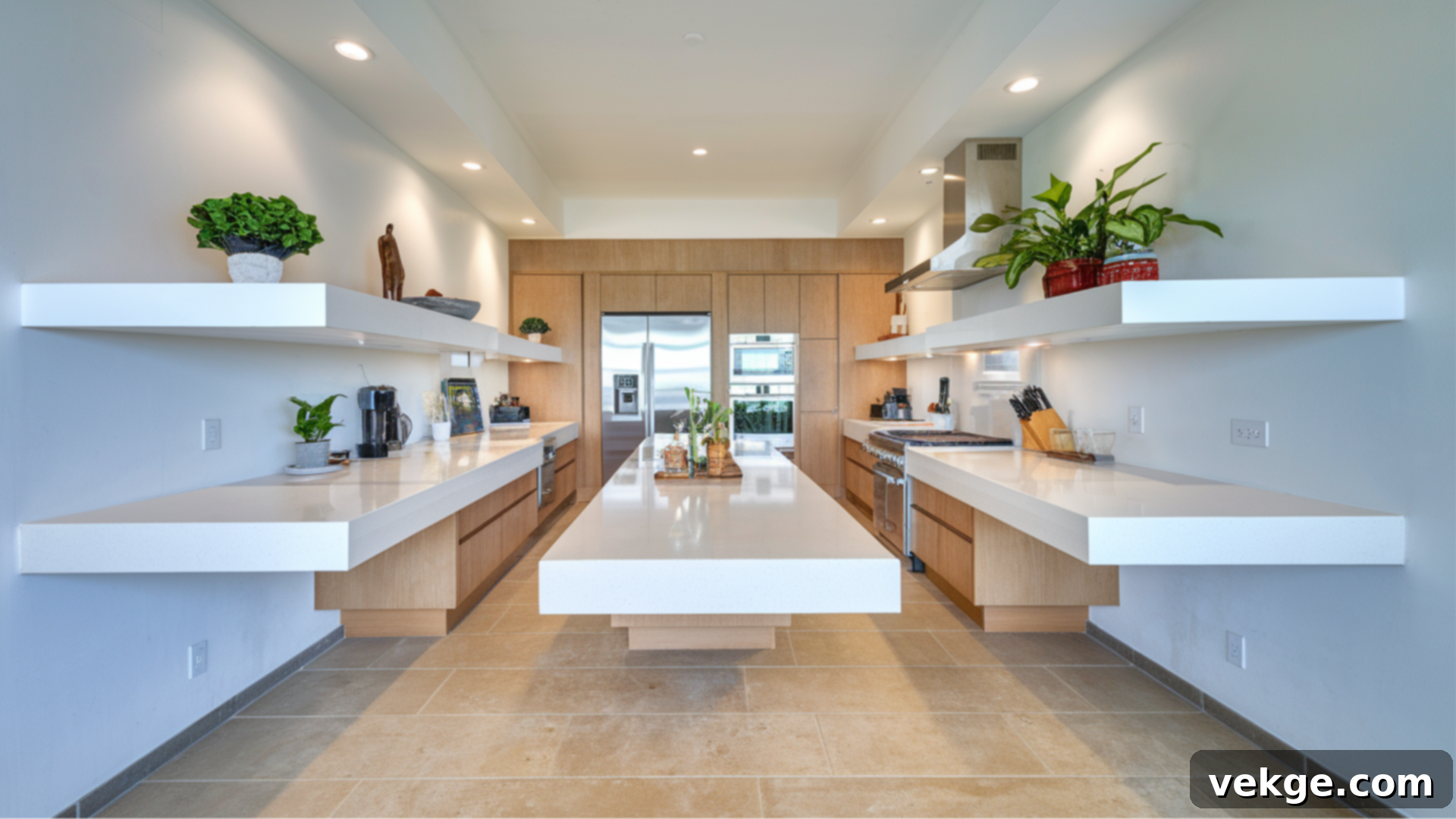
Achieve an airy, expansive feel with floating countertops. By mounting the countertop directly to the wall without visible base cabinets or supports, you create an illusion of lightness and provide more open space beneath. This design significantly reduces visual weight, making the kitchen feel larger, more open, and easier to clean, while still offering a functional surface for prep or dining.
2. Integrated Appliances
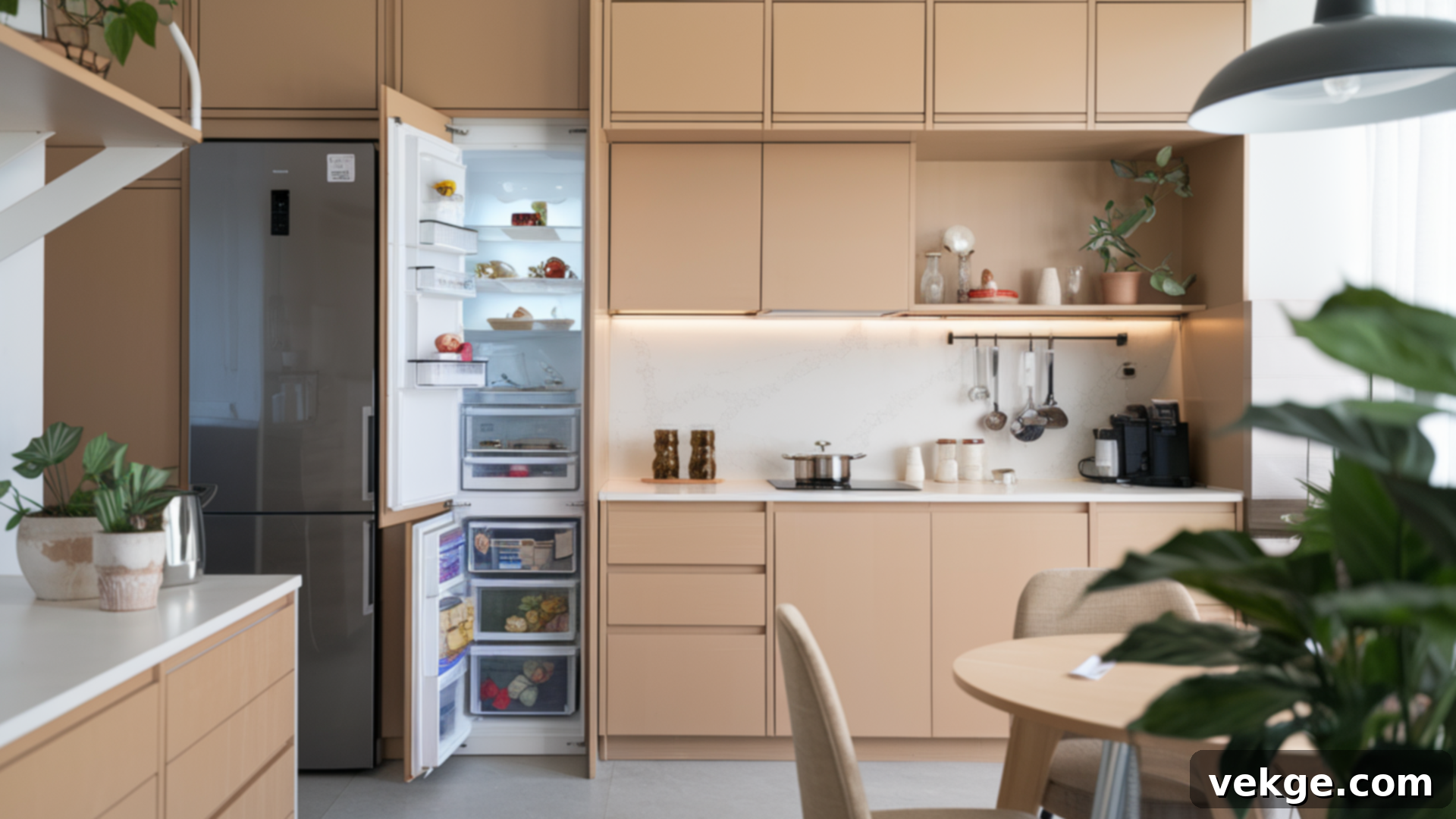
For a truly seamless and clutter-free look, integrate appliances like refrigerators, dishwashers, and even microwaves directly into your cabinetry. This design approach conceals the appliances behind panels that match your kitchen cabinets, creating a continuous, unbroken line of surfaces. It not only maximizes storage space visually but also gives the entire kitchen a sleek, cohesive, and sophisticated appearance, where every element blends harmoniously.
3. Multi-Functional Kitchen Island
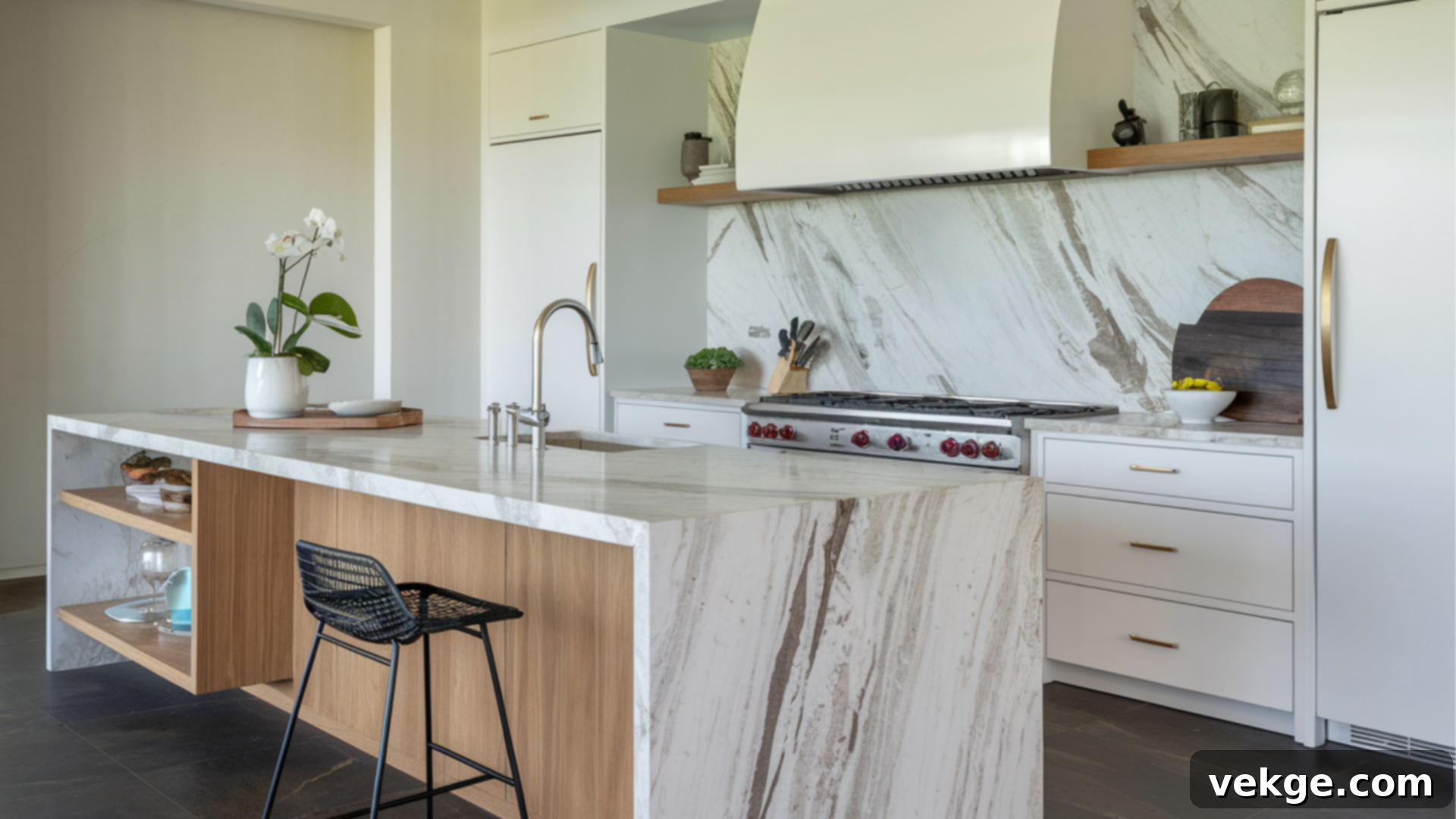
A multi-functional kitchen island is a cornerstone of efficiency in a minimalist space. Design an island that serves multiple purposes: storage with built-in drawers or shelves, a seating area for quick meals or socializing, and an expansive prep area. This centralized hub reduces the need for extra furniture, improves workflow, and maintains the sleek, uncluttered design ethos crucial for a minimalist kitchen.
4. Soft Backlighting
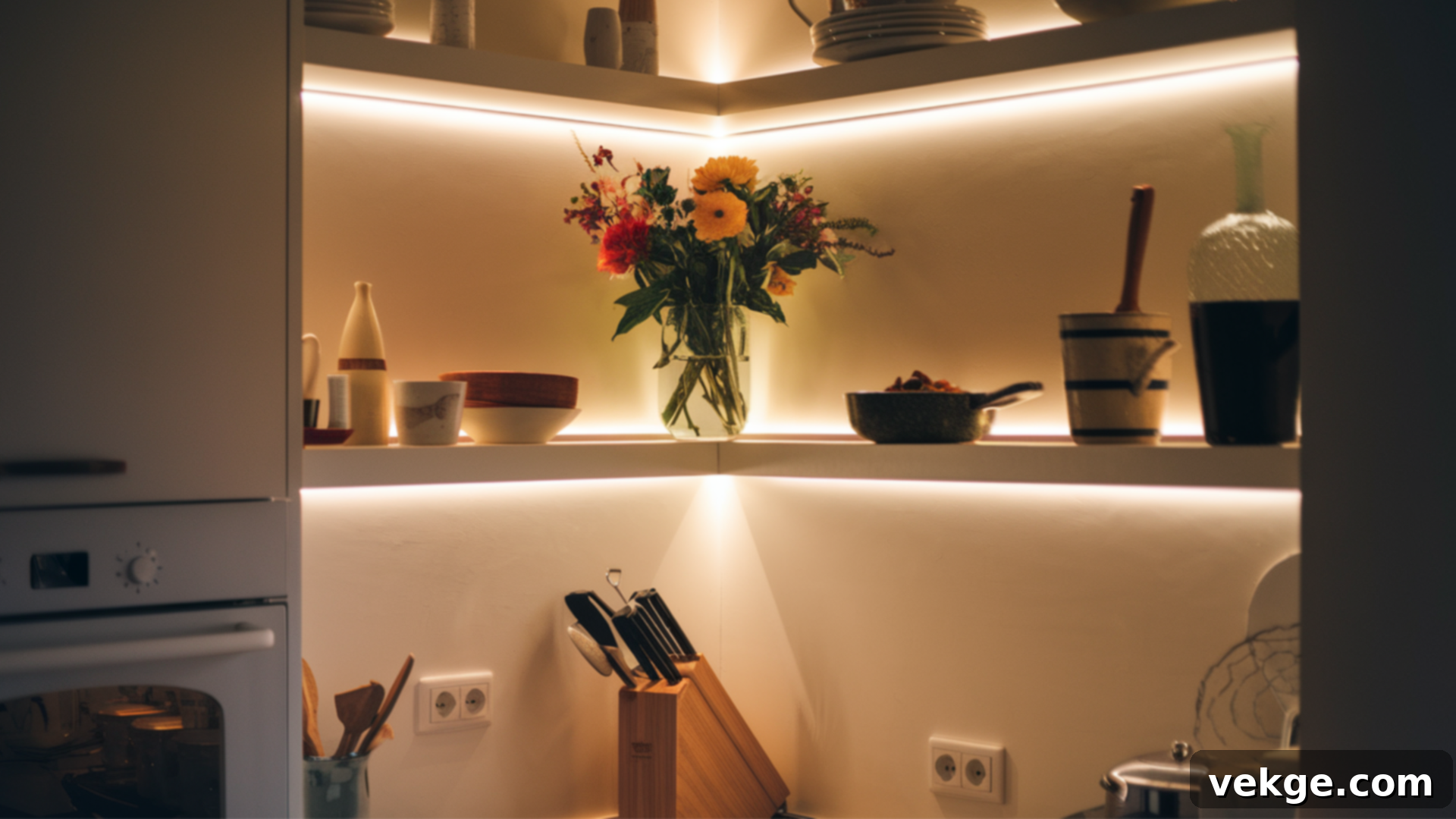
Enhance the ambiance and highlight key features without overwhelming the space by installing soft backlighting. LED strips under shelves, inside glass cabinets, or behind a backsplash can create a subtle glow that adds depth, warmth, and an inviting atmosphere. This gentle illumination is both functional for task lighting and aesthetically pleasing, contributing to the serene feel of a minimalist kitchen design.
5. Concealed Trash and Recycling
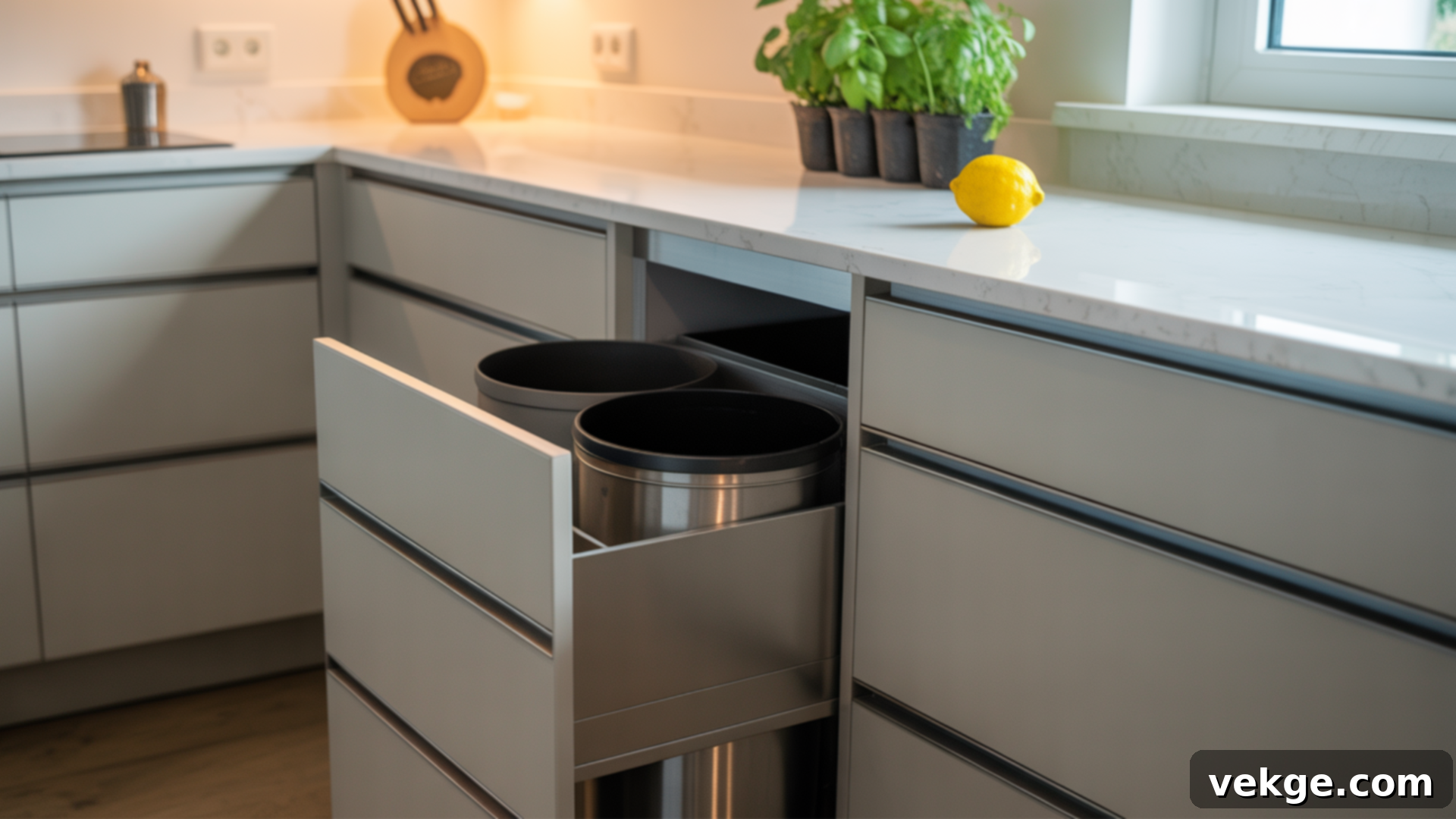
Maintain a truly neat and organized kitchen by hiding unsightly trash and recycling bins within cabinetry. Pull-out systems that house multiple bins make sorting easy while keeping them completely out of sight. This design choice is fundamental to a minimalist aesthetic, ensuring the kitchen remains visually clean and functional without compromising on convenience or hygiene.
6. Compact, Multi-Use Appliances
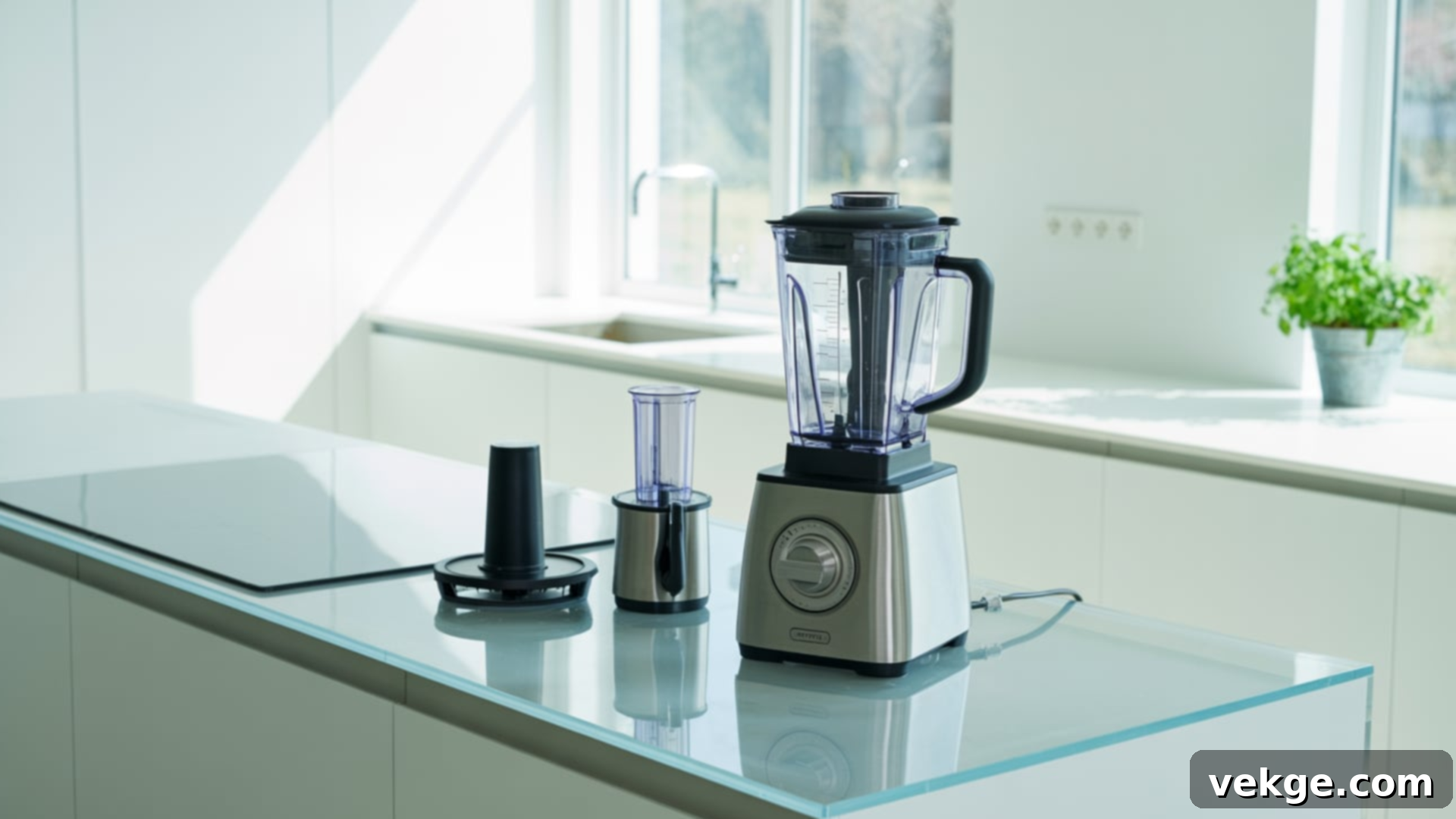
In a minimalist kitchen, every item should earn its place. Opt for small, versatile appliances that can perform multiple functions, thereby conserving valuable counter and storage space. Think of a high-quality blender that also functions as a food processor, or a toaster oven that doubles as a small convection oven. This strategic selection keeps your kitchen practical, yet beautifully clutter-free.
7. Storage Solutions
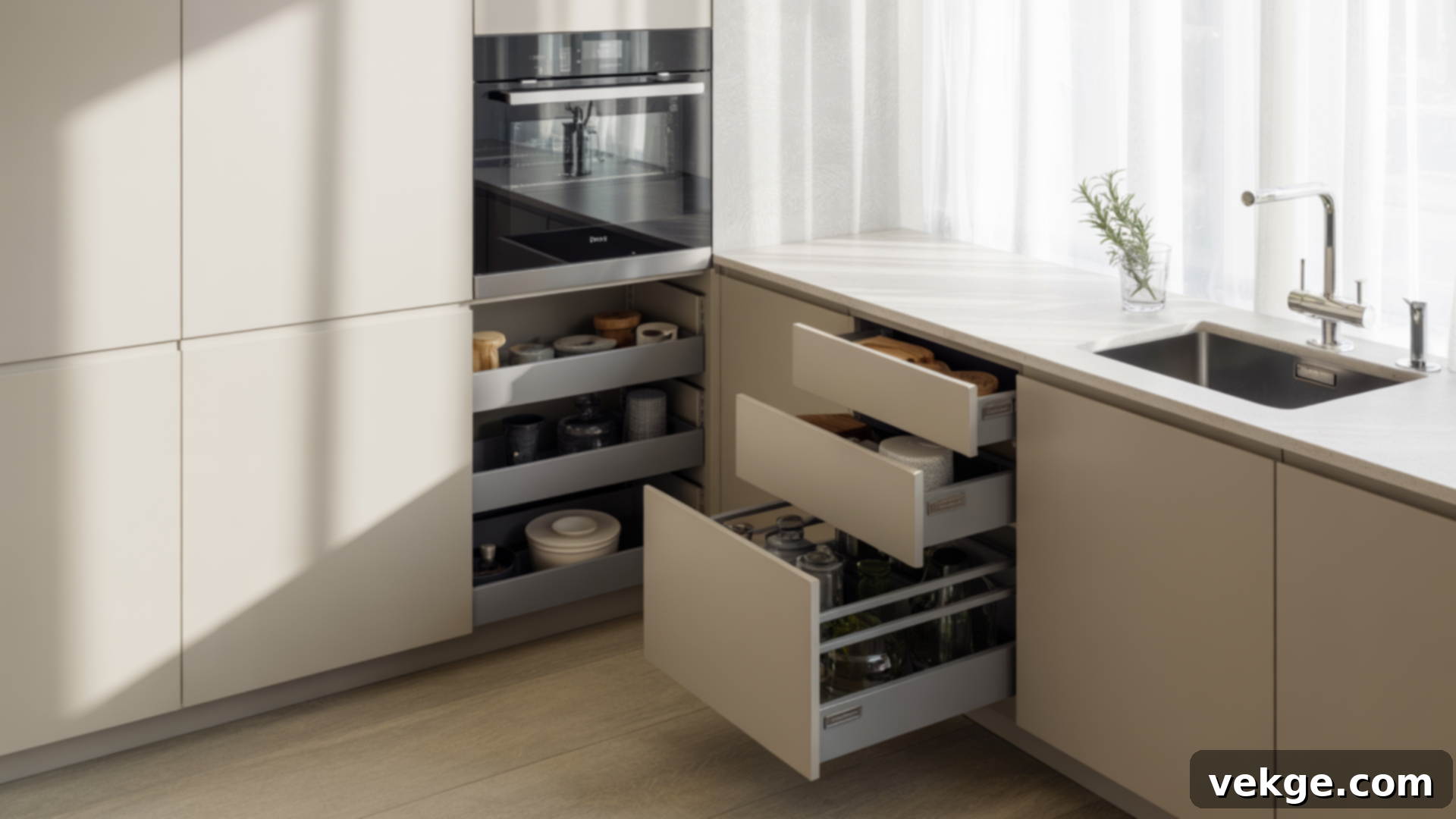
Effective hidden storage is paramount. Utilize pull-out drawers, deep pantry cabinets, and custom built-in solutions to keep all kitchen essentials neatly organized and out of sight. From dishware to small appliances, a well-designed storage system ensures easy access while maintaining a consistently tidy and clutter-free kitchen, making it a joy to navigate and work within.
8. Monochromatic Colour Scheme

Embrace the calming power of a monochromatic color scheme. By sticking to variations of a single neutral color – be it white, grey, or beige – you create a harmonious and cohesive kitchen atmosphere. This palette enhances the sense of simplicity and spaciousness, ensuring that no single element visually competes, allowing the clean lines and textures to truly stand out.
9. Streamlined Cabinet Handles
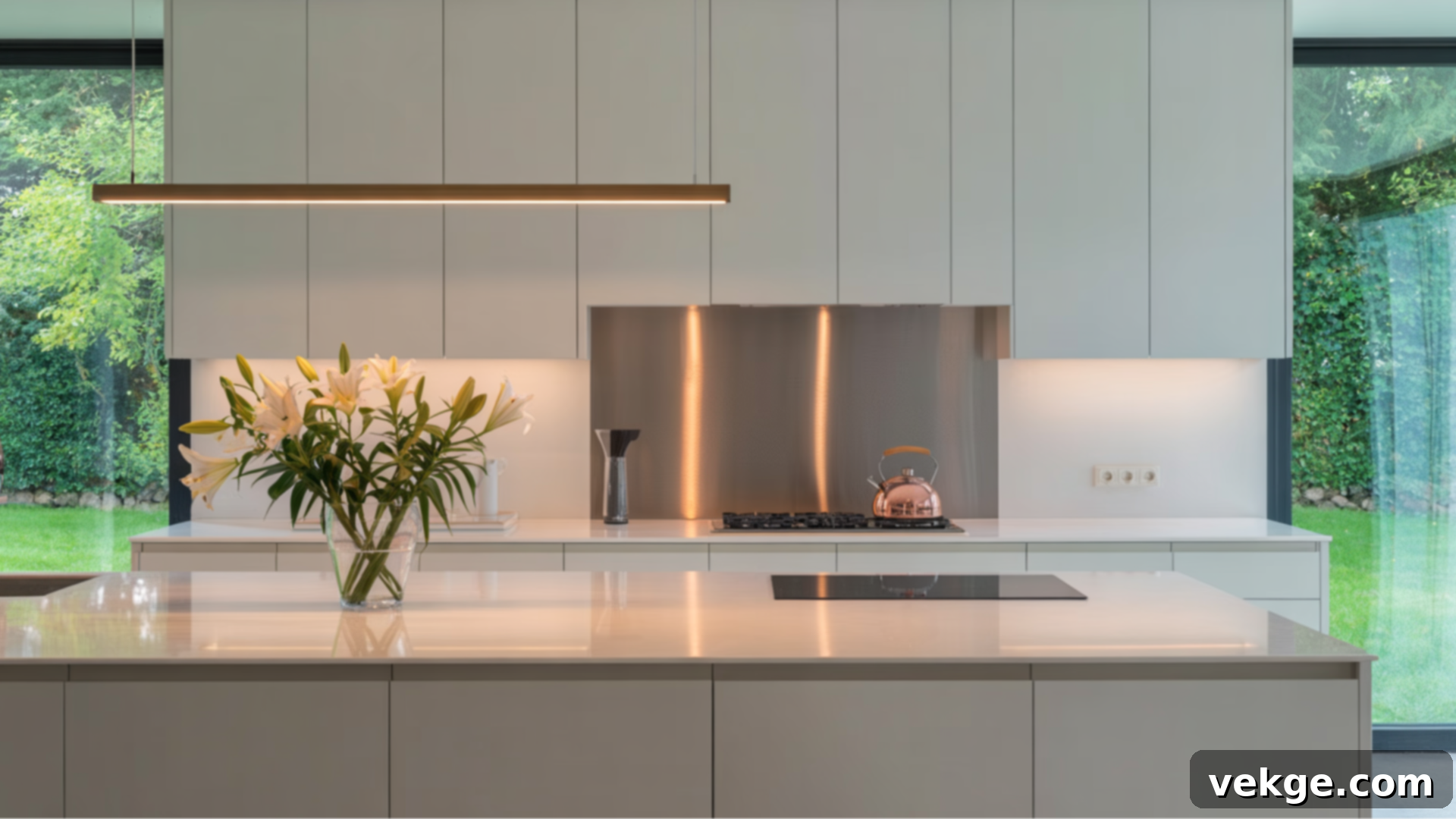
Eliminate visual distractions with streamlined cabinet handles or, even better, opt for handleless cabinets with push-to-open mechanisms or integrated finger pulls. This design choice creates a smooth, clean, and uninterrupted surface across your cabinetry, contributing significantly to a modern and sleek aesthetic. The absence of visible hardware ensures the kitchen feels truly minimalist and effortlessly sophisticated.
10. Open Shelving with Limited Items
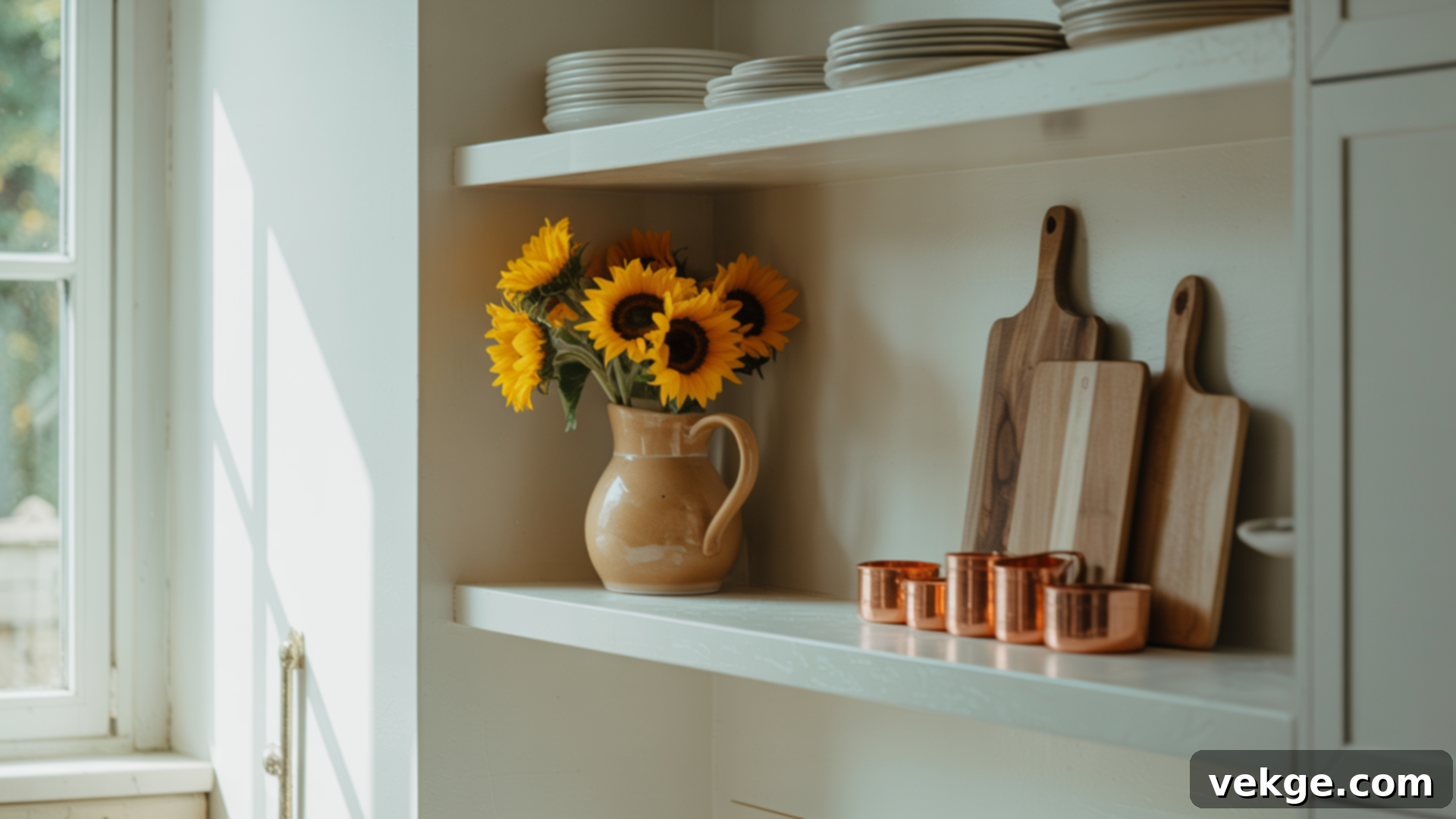
While minimalism often favors hidden storage, open shelving can be incorporated effectively if done with intention. Display only a few essential, visually pleasing items – think elegant ceramics, a small collection of cookbooks, or neatly stacked plates. This approach prevents mess, maintains an organized look, and adds a touch of personality without compromising the clean, functional essence of your minimalist space.
11. Wall-Mounted Faucets
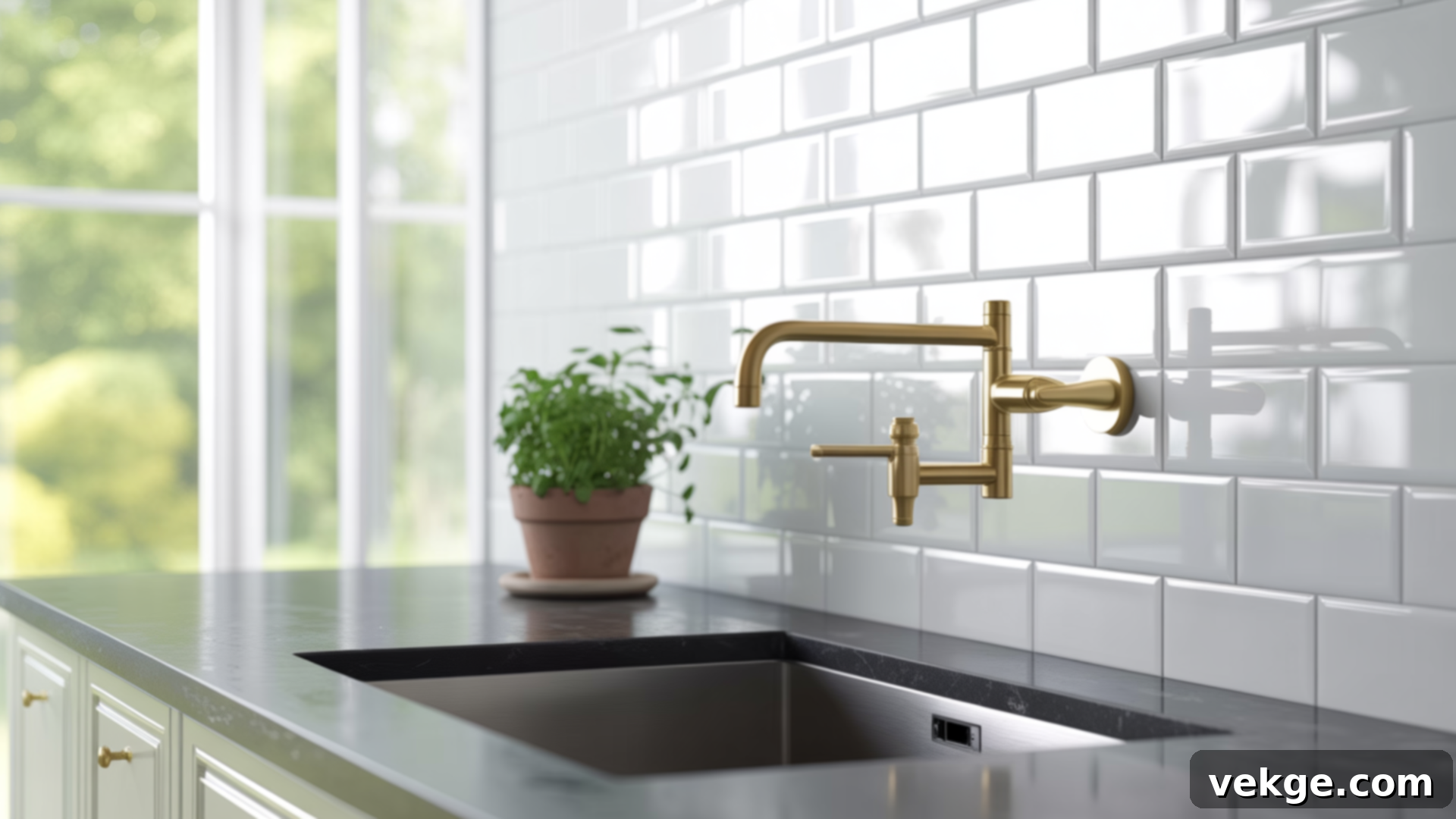
Free up valuable counter space around your sink and elevate the kitchen’s modern appeal with a wall-mounted faucet. This sleek design minimizes visual clutter on the countertop, making it easier to clean and providing more flexibility for various sink activities. It’s a sophisticated and practical choice that perfectly aligns with a minimalist aesthetic.
12. Smart Kitchen Technology
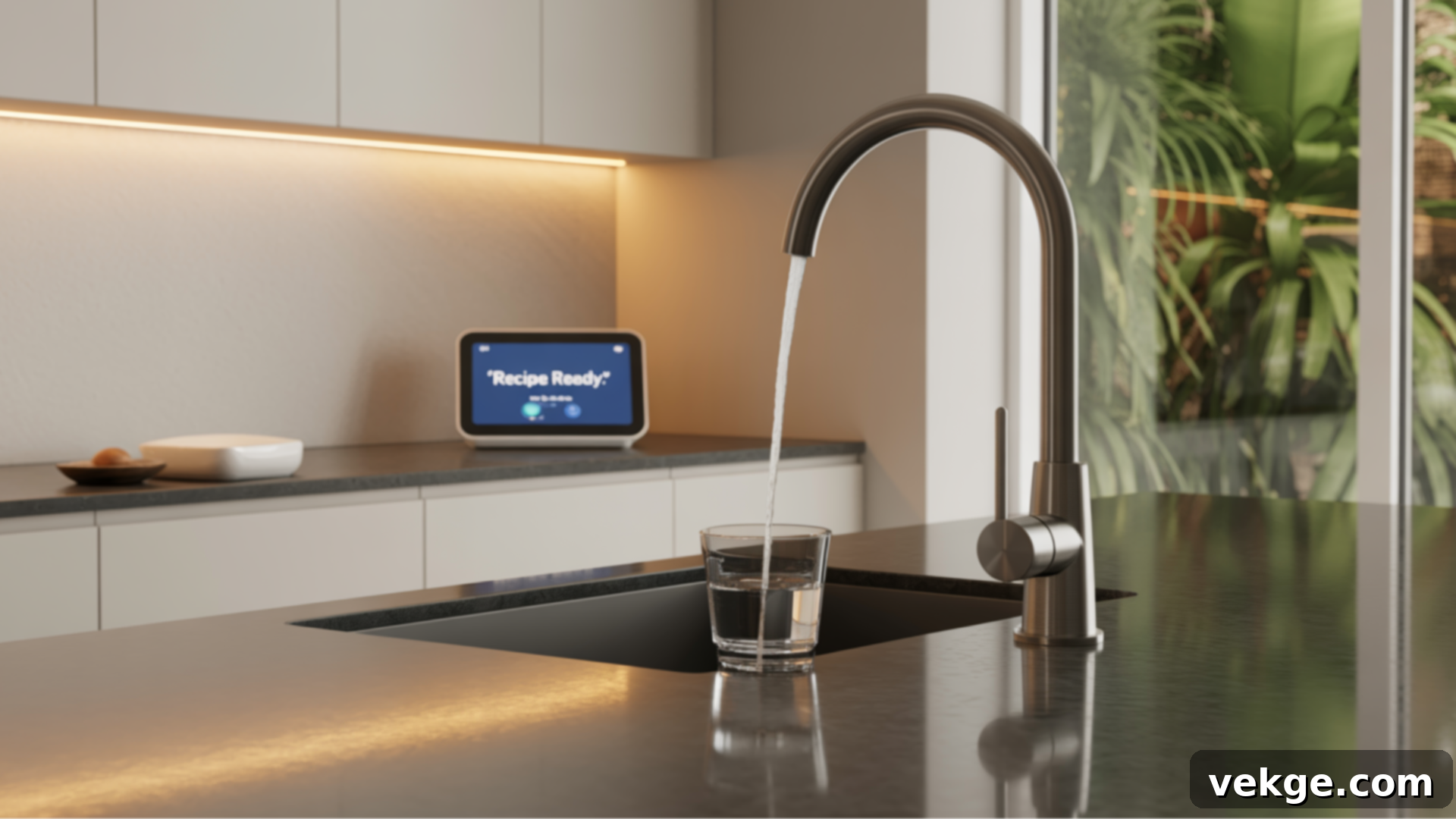
Integrate smart devices to enhance functionality and convenience without adding visual bulk. Voice-controlled assistants, touchless faucets, or smart lighting systems can save time and effort, streamlining your kitchen experience. When chosen thoughtfully, these technologies blend seamlessly into the minimalist vibe, adding modern efficiency discreetly.
13. Glass Cabinet Doors
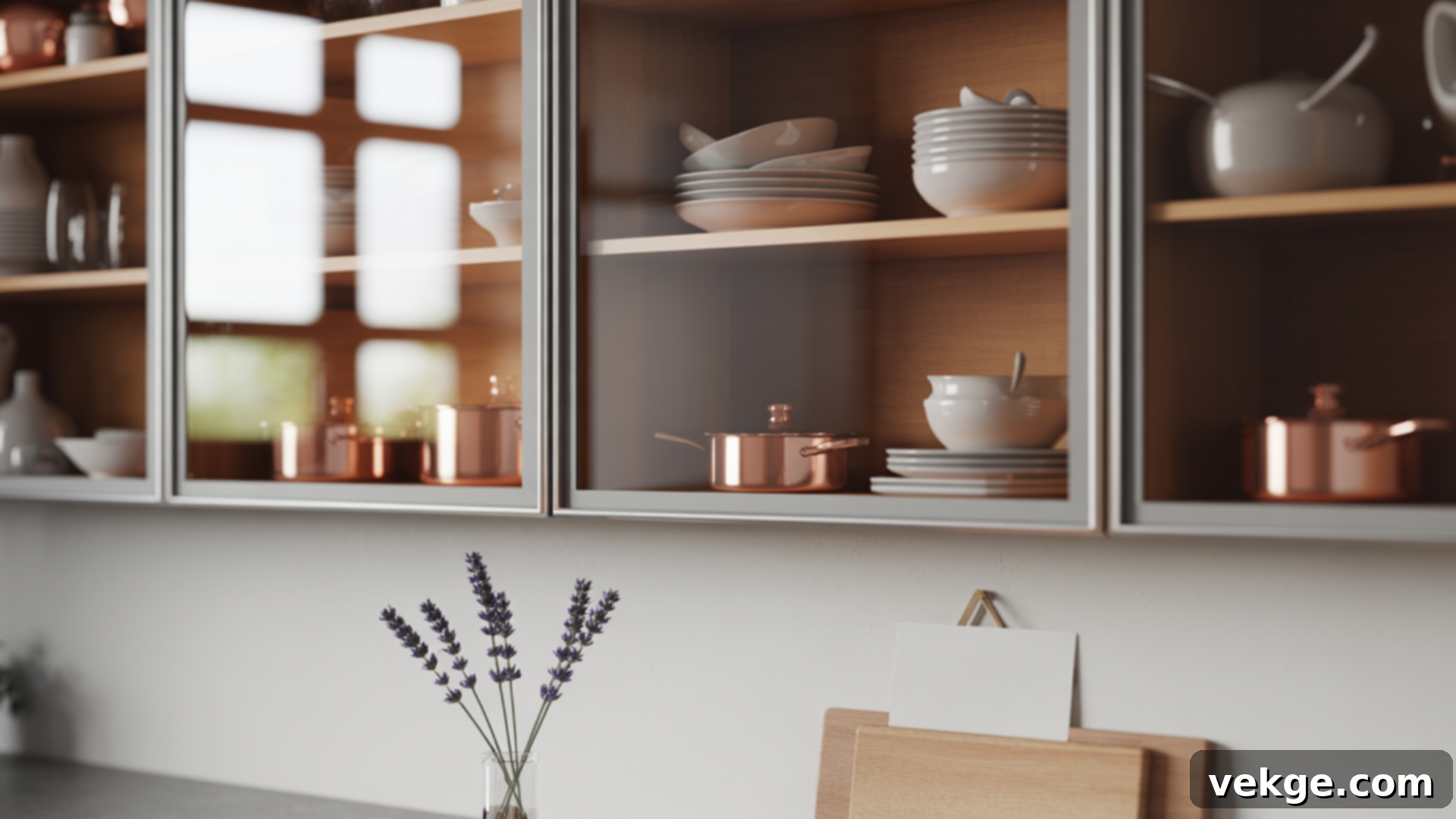
Utilize frosted or clear glass cabinet doors to display select, neatly arranged items, contributing to an open and airy feel. Glass doors help create visual depth and prevent the kitchen from feeling heavy or boxy. This choice allows you to showcase essential or decorative items in an organized manner without overcrowding the space, striking a perfect balance between visibility and discretion.
14. Floating Sink
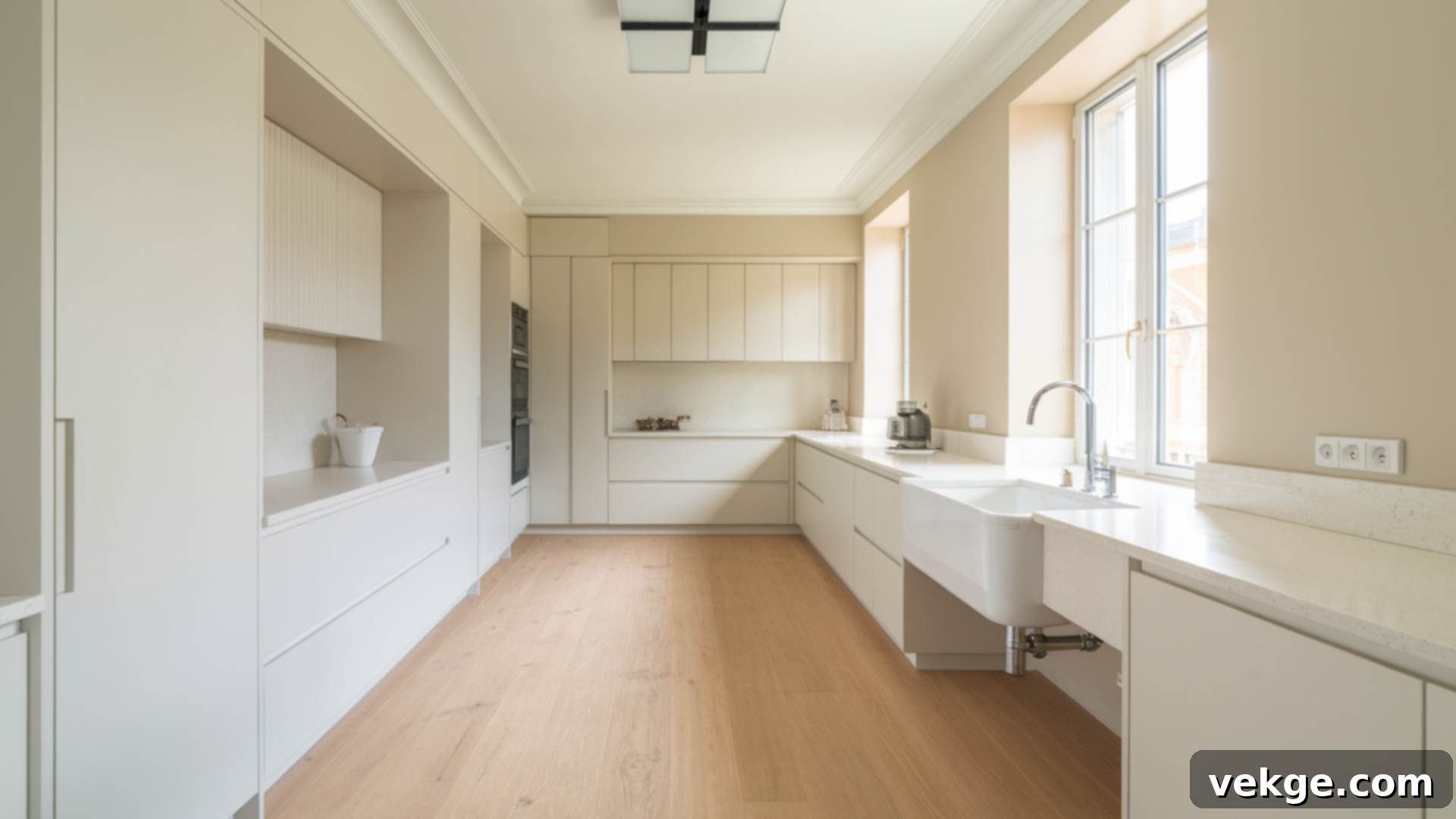
Similar to floating countertops, a floating sink installation creates a distinct modern look and provides an unobstructed area beneath. This design makes the kitchen feel less cramped and significantly contributes to an open aesthetic, offering both minimalist elegance and practical space for storage or simplified cleaning. It’s an innovative approach to an essential kitchen feature.
15. Minimalist Bar Area
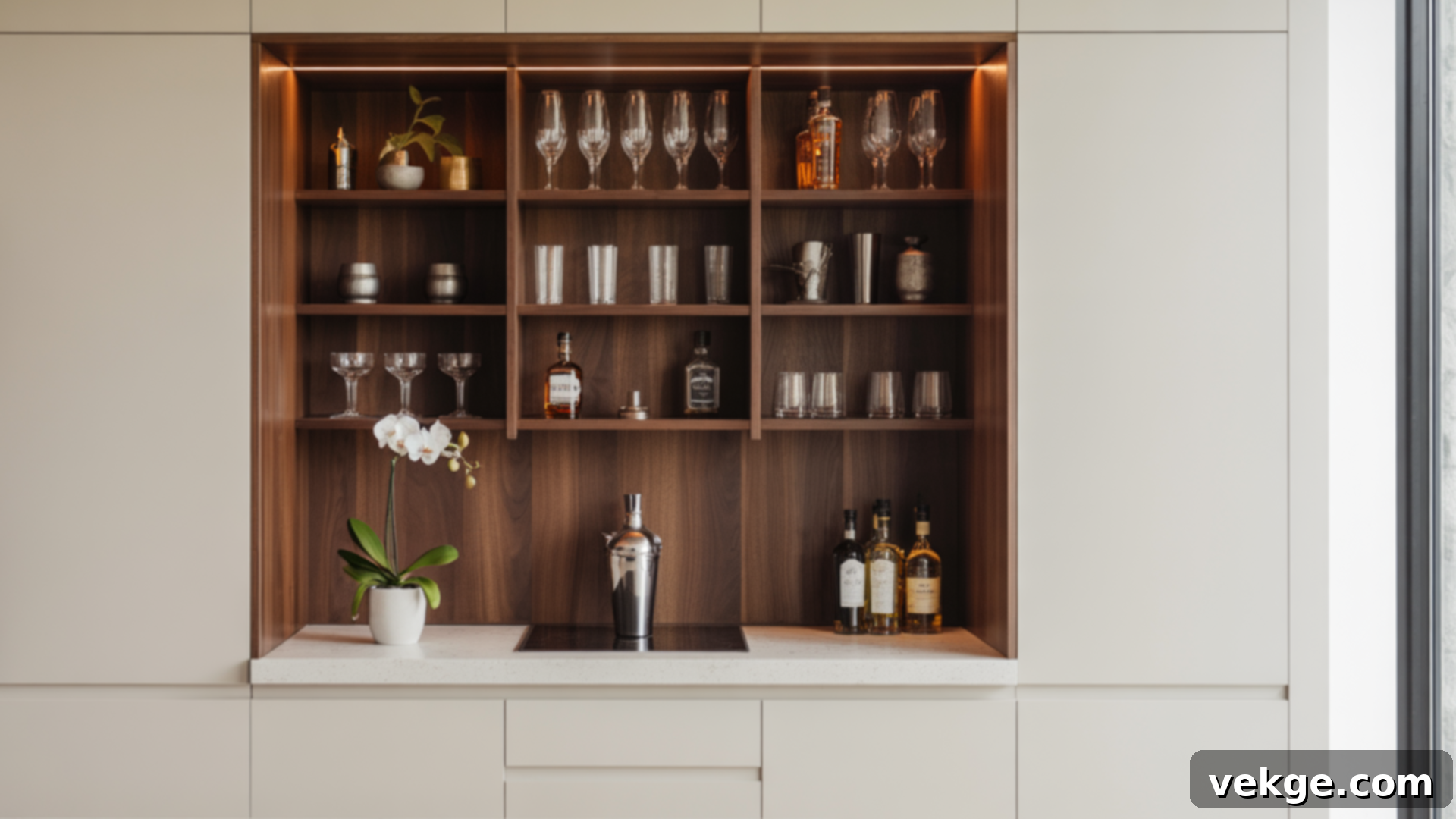
If your lifestyle includes entertaining, incorporate a small, built-in bar area with sleek, uncluttered shelving. Focus on essential barware and a clean design to keep the area functional yet minimalist. This provides an elegant and organized space for preparing drinks or serving guests, enhancing the kitchen’s utility without disrupting its clean, simple aesthetic.
16. Use Mirrored Surfaces
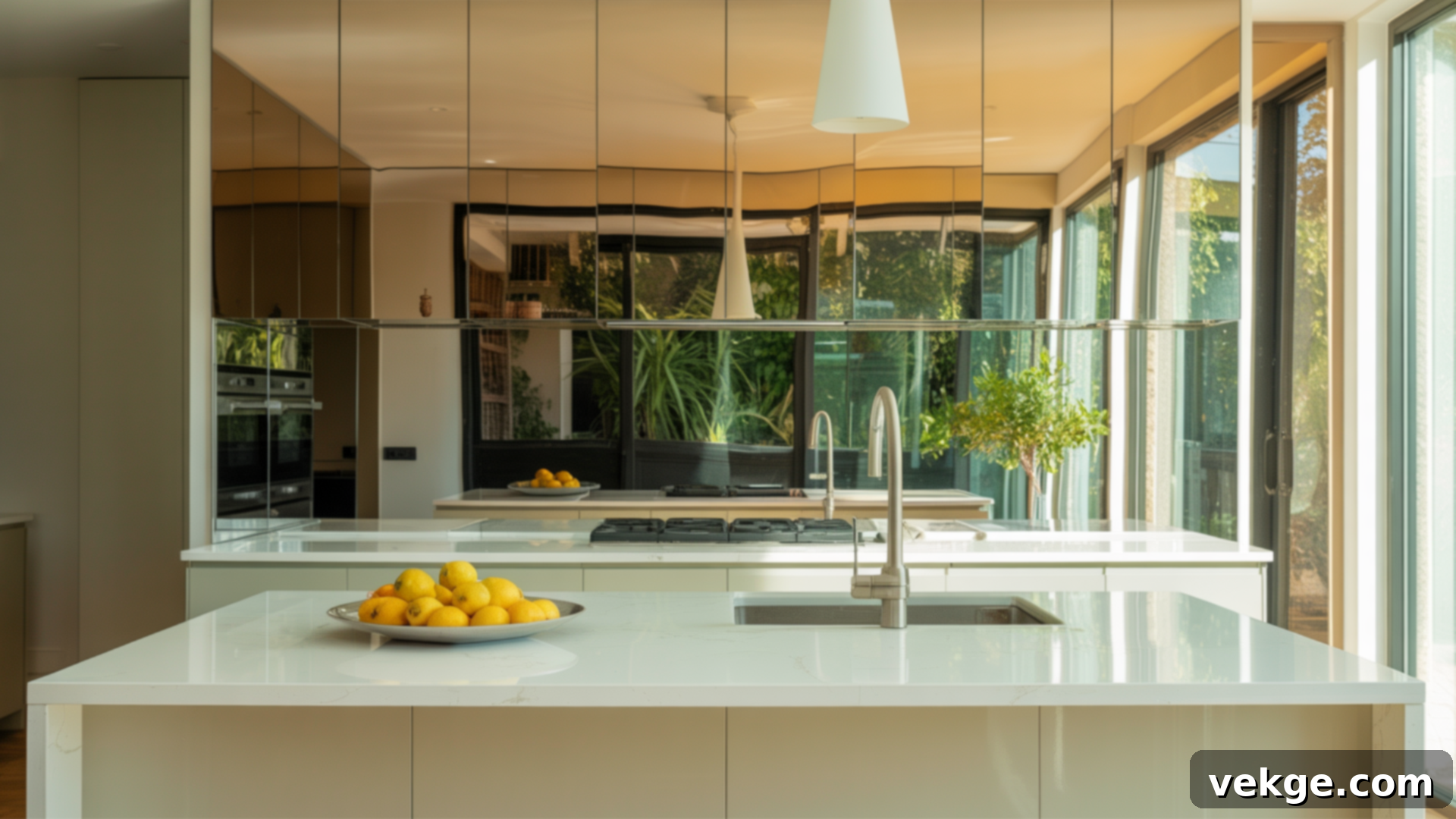
Introduce mirrored backsplashes or cabinet panels to reflect light and visually expand the kitchen. This clever design feature creates a powerful sense of openness and depth, making even smaller kitchens feel significantly larger and brighter. Mirrored surfaces add a touch of modern glamour while aligning perfectly with the airy, spacious feel desired in minimalist design.
17. Maximise Vertical Storage

Harness the power of vertical space by utilizing tall cabinets, floor-to-ceiling pantries, or open shelves that extend upwards. This strategy optimizes storage capacity, keeping counters clear and all essentials neatly stowed away. Maximizing vertical storage is key to maintaining an efficient and clutter-free kitchen, especially in smaller spaces, without sacrificing the minimalist aesthetic.
18. Include a Pull-Out Coffee Bar
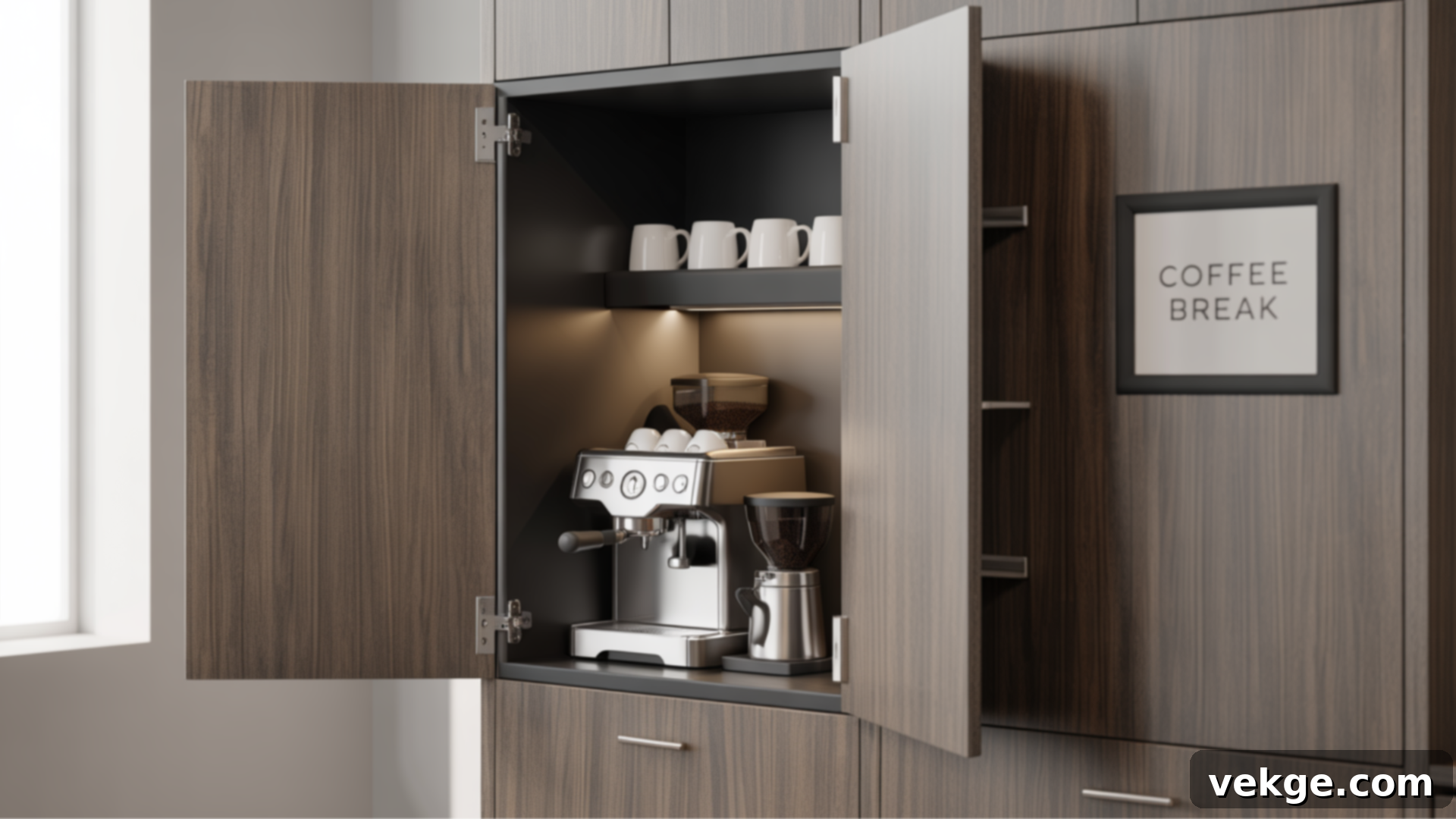
A hidden, pull-out coffee station is an ingenious way to keep your kitchen organized and your countertops pristine. Designed to integrate seamlessly into cabinetry, it houses your coffee maker, mugs, and supplies. When not in use, it tucks away discreetly, maintaining the clean lines and clutter-free appearance that defines a minimalist kitchen.
19. Install Hidden Drawer Organisers
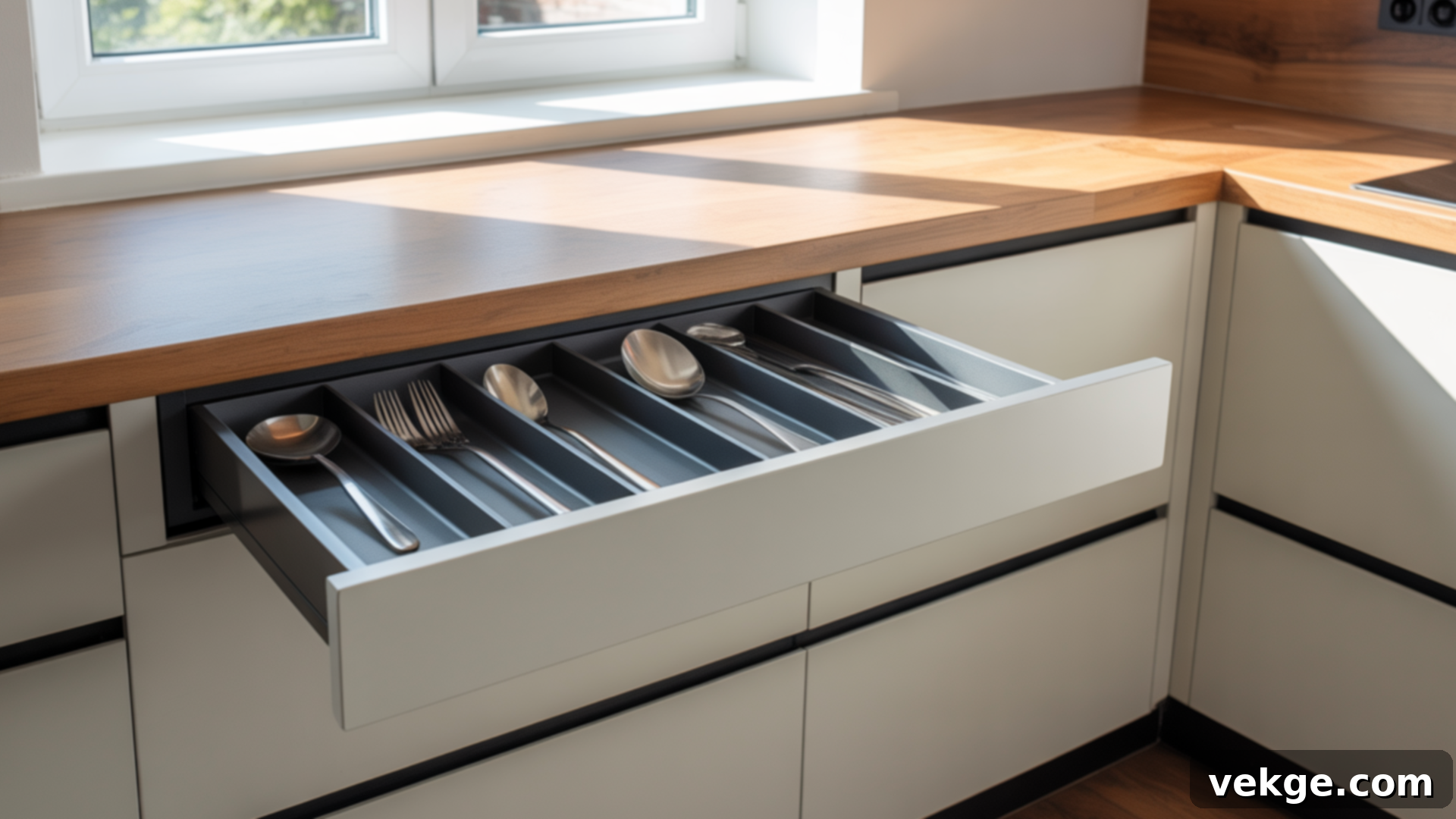
Maximize internal drawer space and maintain a pristine look with hidden drawer organizers. Custom inserts for utensils, knives, spices, and even plates ensure everything has its designated spot, keeping tools neatly tucked away and preventing clutter. This design choice ensures a clean, streamlined aesthetic without compromising on functionality or accessibility.
20. Add Minimalist Wall Art
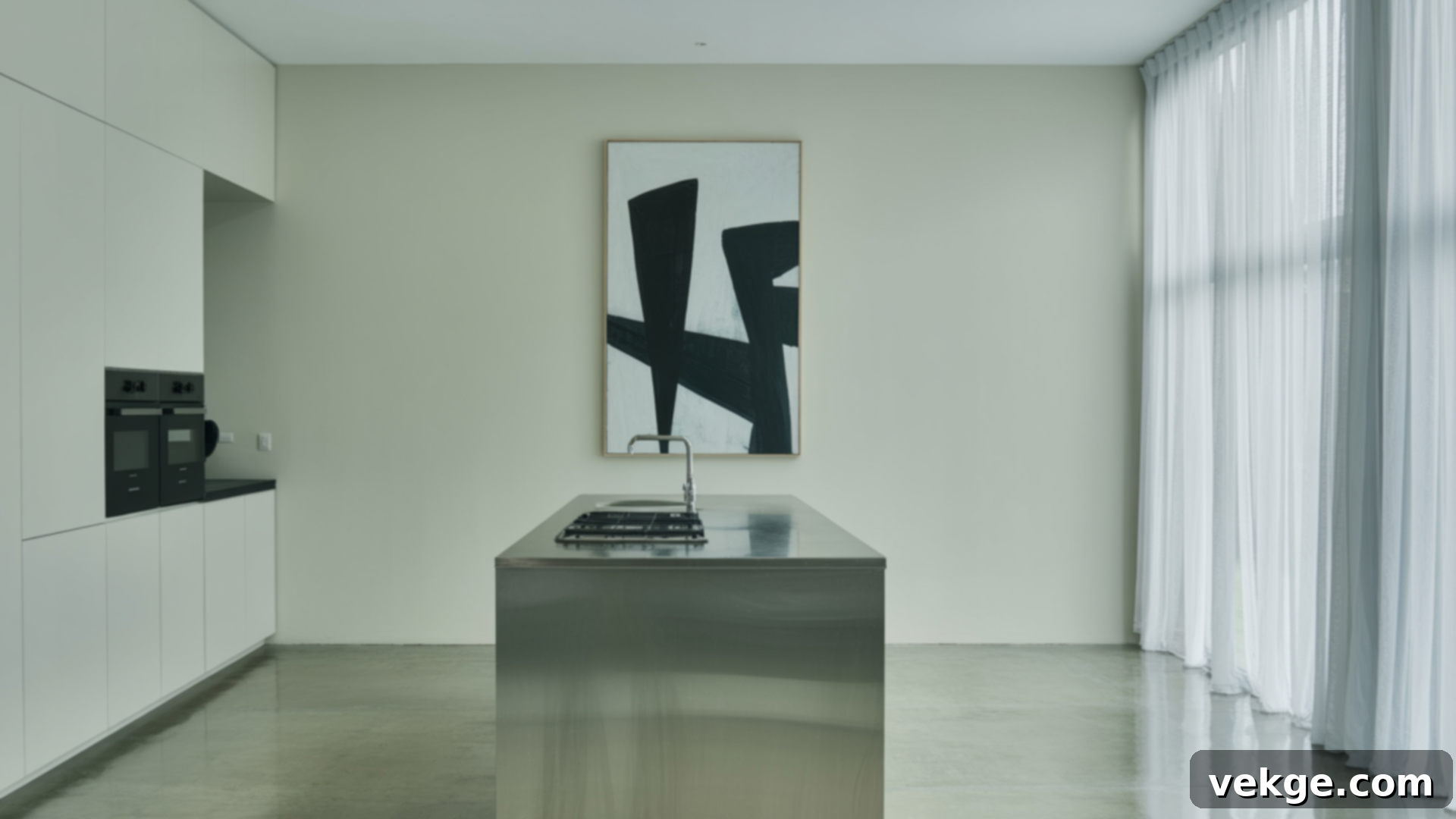
Infuse personality and warmth into your minimalist kitchen with carefully selected, simple wall art. Opt for abstract pieces, monochromatic prints, or subtle geometric designs that complement the overall aesthetic without overwhelming the space. Well-chosen art can soften hard lines, add a focal point, and enhance the atmosphere, contributing to a curated and inviting environment.
21. Use Transparent Cabinet Doors
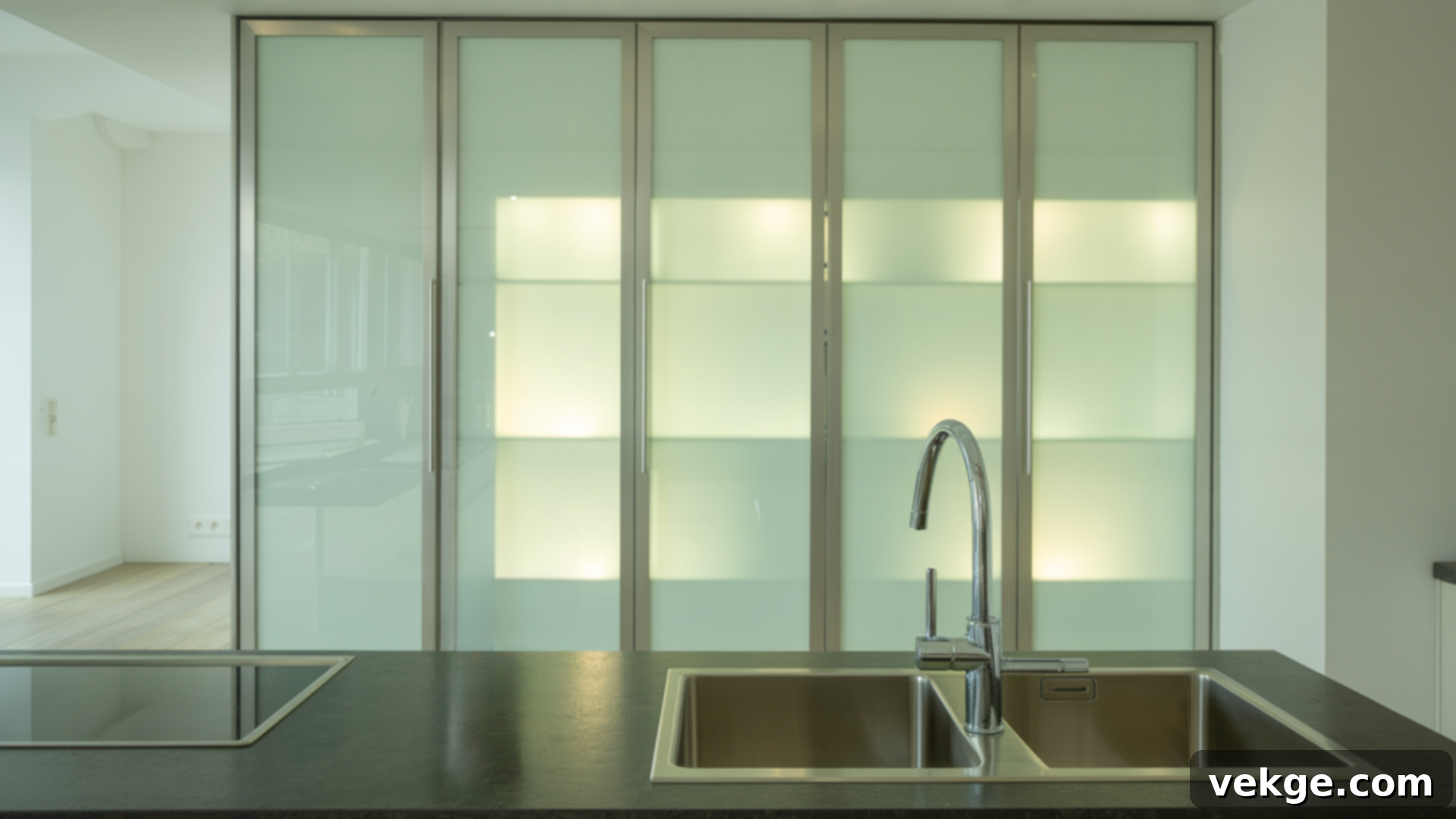
Transparent or frosted glass cabinet doors can make a kitchen feel significantly lighter and more open. This design choice allows for the visual display of neatly organized dinnerware or glassware, adding visual interest and depth without contributing to a cluttered look. It strikes a beautiful balance between functional storage needs and a modern, uncluttered design ethos.
22. Combine Kitchen and Dining Area

An open-plan layout that seamlessly combines the kitchen and dining areas creates a cohesive, spacious environment. This design enhances functionality, improves flow, and encourages social interaction, making the kitchen the true heart of the home. By designing these areas as a single unit with matching aesthetics, you maintain a strong minimalist design while maximizing usability.
23. Choose Compact Appliances
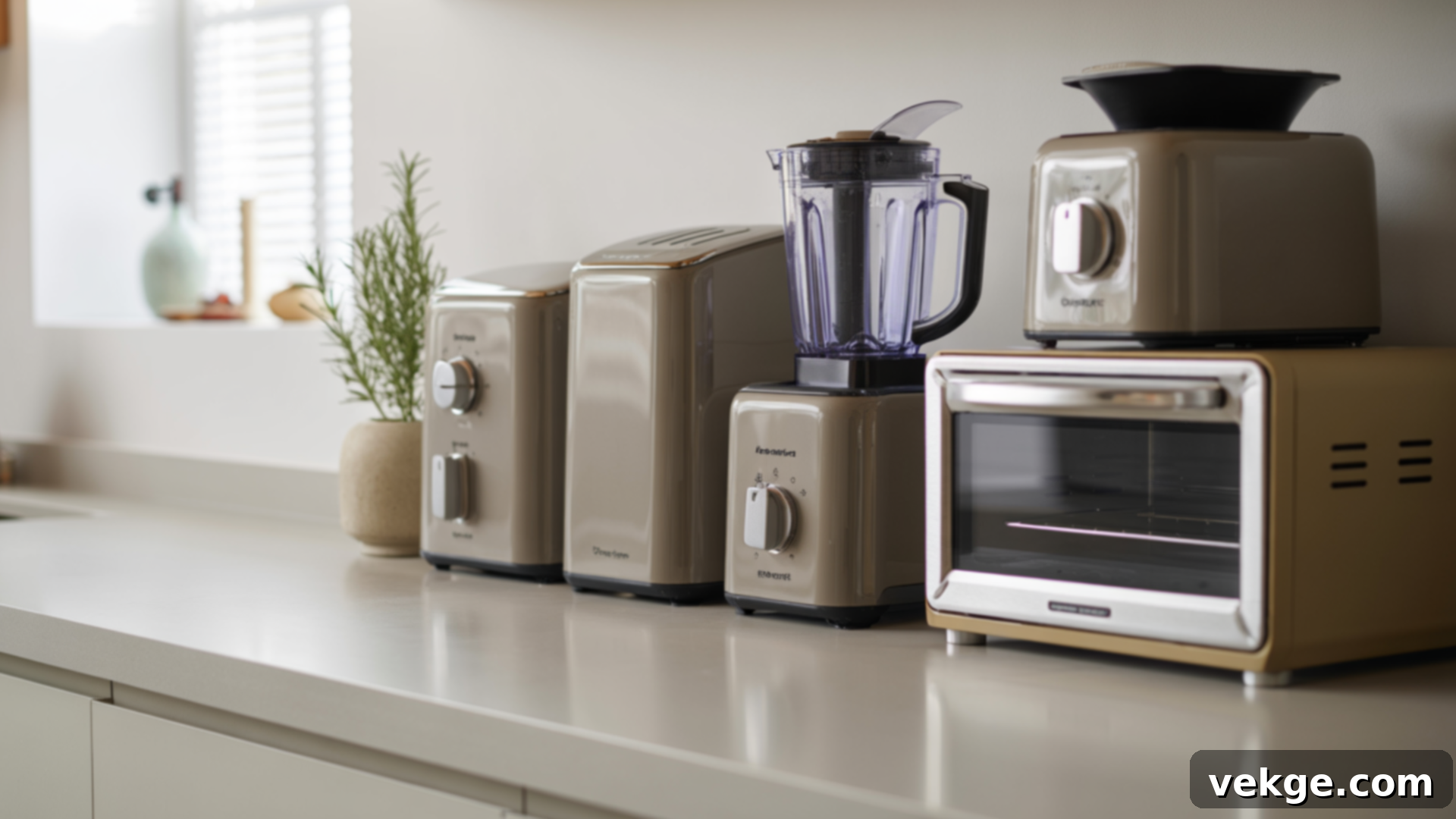
Especially for smaller minimalist kitchens, selecting compact, multi-functional appliances is a game-changer. These efficiently designed tools save valuable counter space and integrate smoothly into the kitchen’s overall design, reducing visual clutter. They ensure you retain essential functionality without sacrificing the sleek, streamlined appearance crucial for a minimalist aesthetic.
24. Create a Minimalist Breakfast Nook
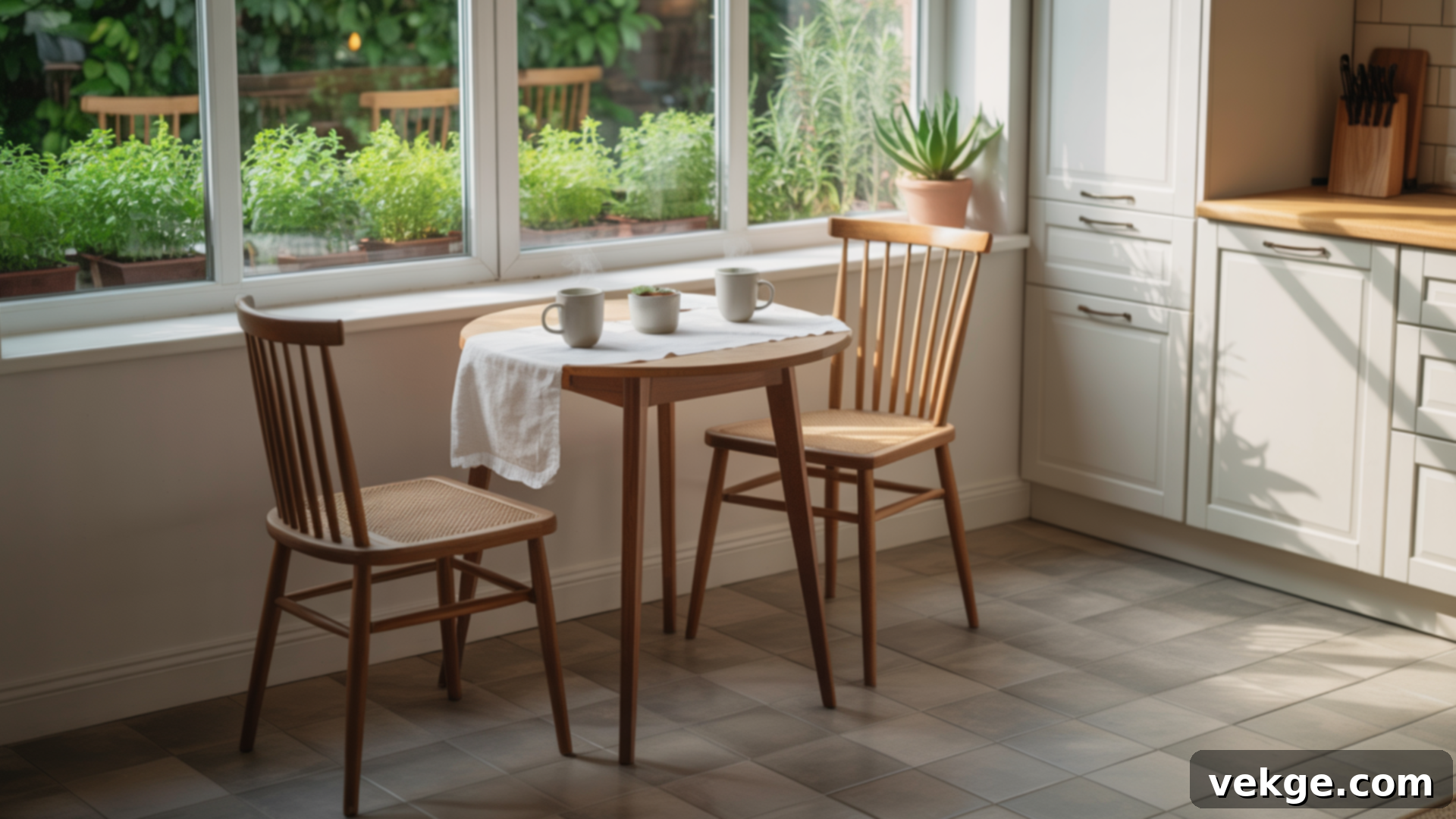
Design a cozy yet highly functional breakfast nook with clean lines and simple furniture that blends seamlessly into the kitchen’s aesthetic. A built-in bench or a compact table and chairs provide an intimate dining space for everyday meals while preserving an open, airy feel. This offers comfort and utility without introducing unnecessary visual bulk.
25. Integrated Drying Racks
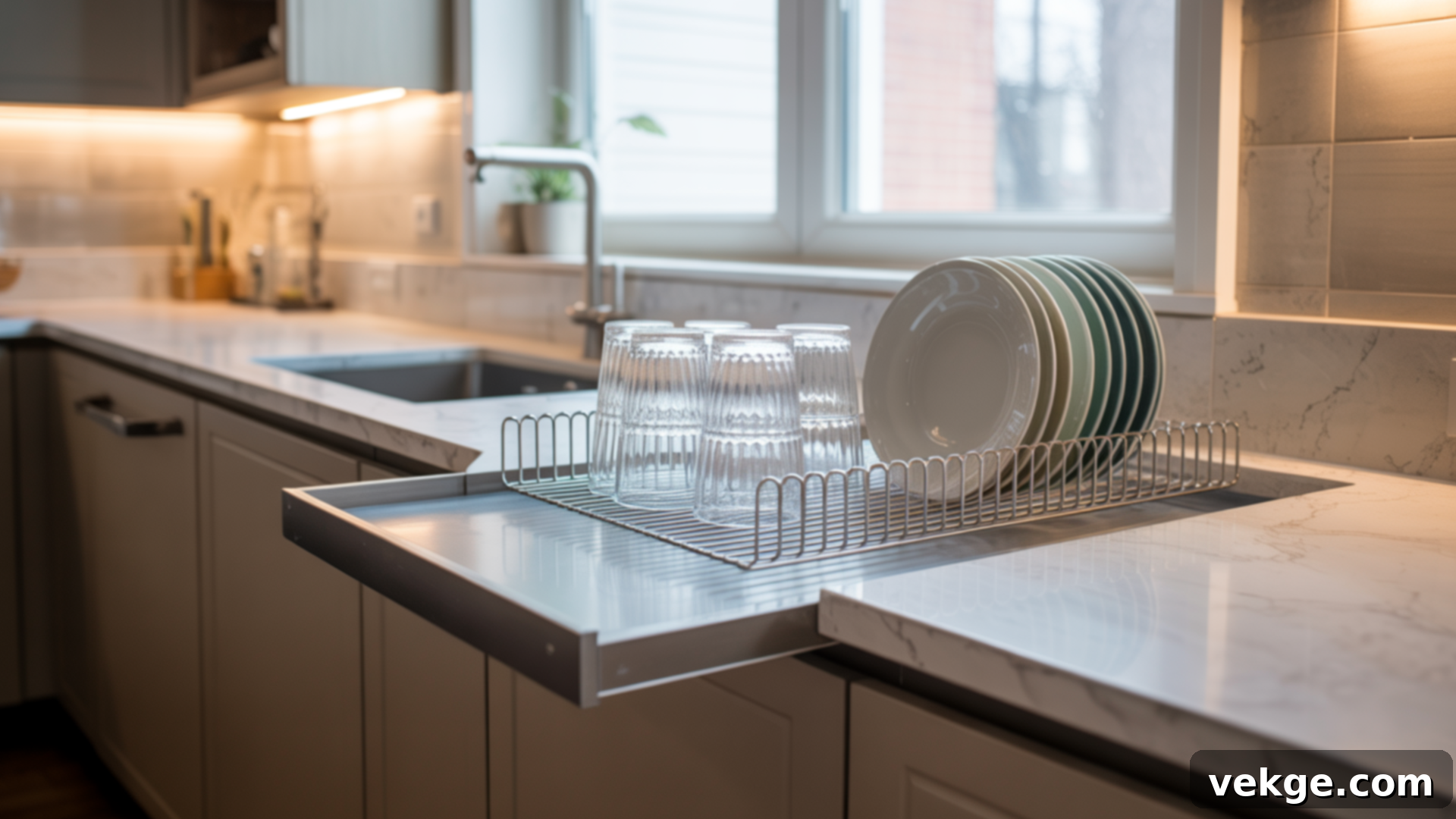
Eliminate countertop clutter with built-in drying racks that slide out from under countertops or cabinets. When not in use, these racks tuck away neatly, maintaining consistently clean and pristine surfaces. This design keeps your kitchen looking organized and visually appealing while still providing practical functionality for drying dishes or utensils discreetly.
26. Statement Lighting Fixtures
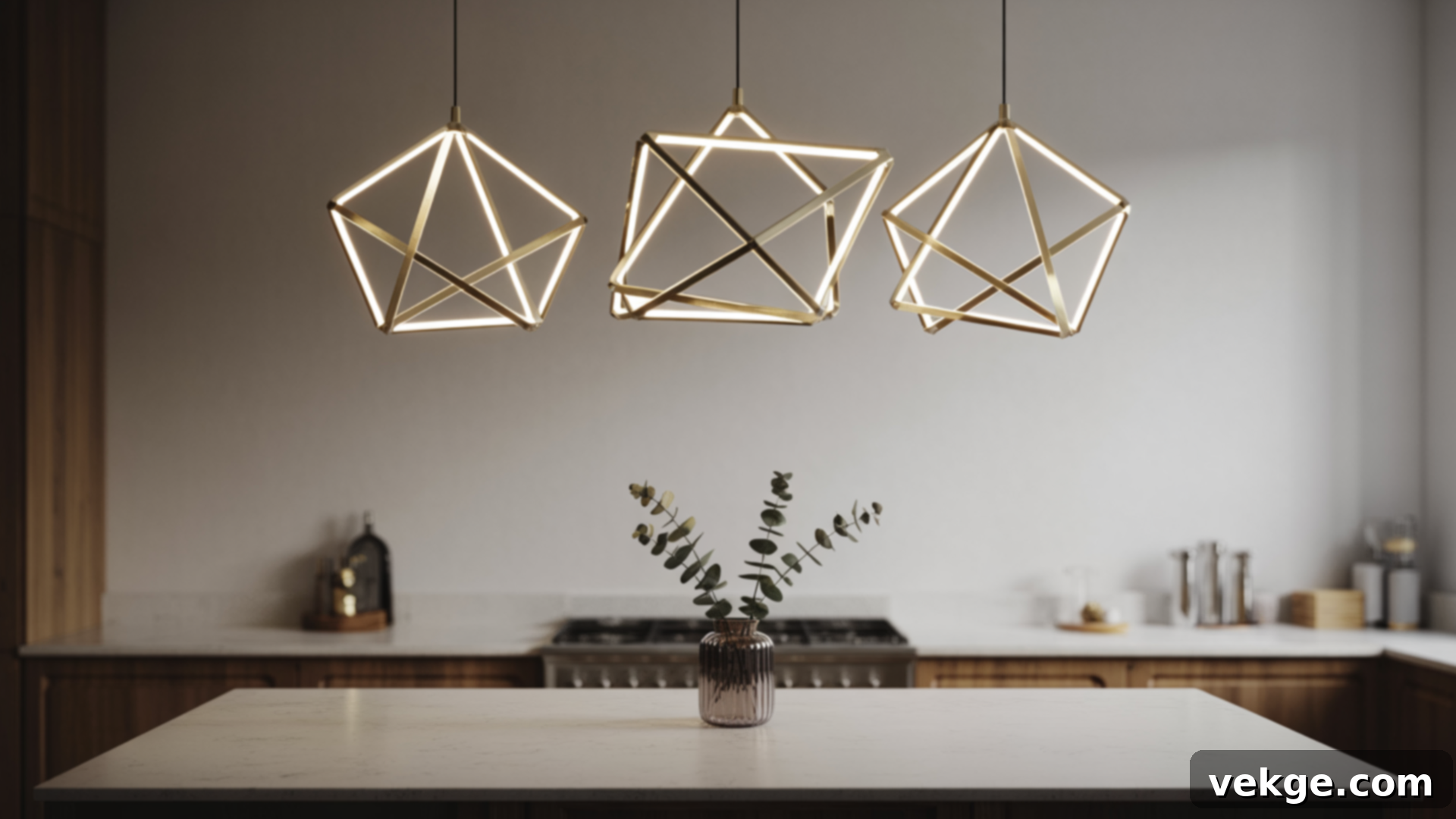
While minimalism values simplicity, a well-chosen statement lighting fixture can act as an artistic focal point without disrupting the clean aesthetic. Replace traditional overhead lights with minimalist, artistic pendant lights or a geometric chandelier. These bold lighting choices provide functional illumination while making a refined, stylish statement, enhancing the kitchen’s atmosphere and design without overwhelming the space.
27. Custom Drawer Systems
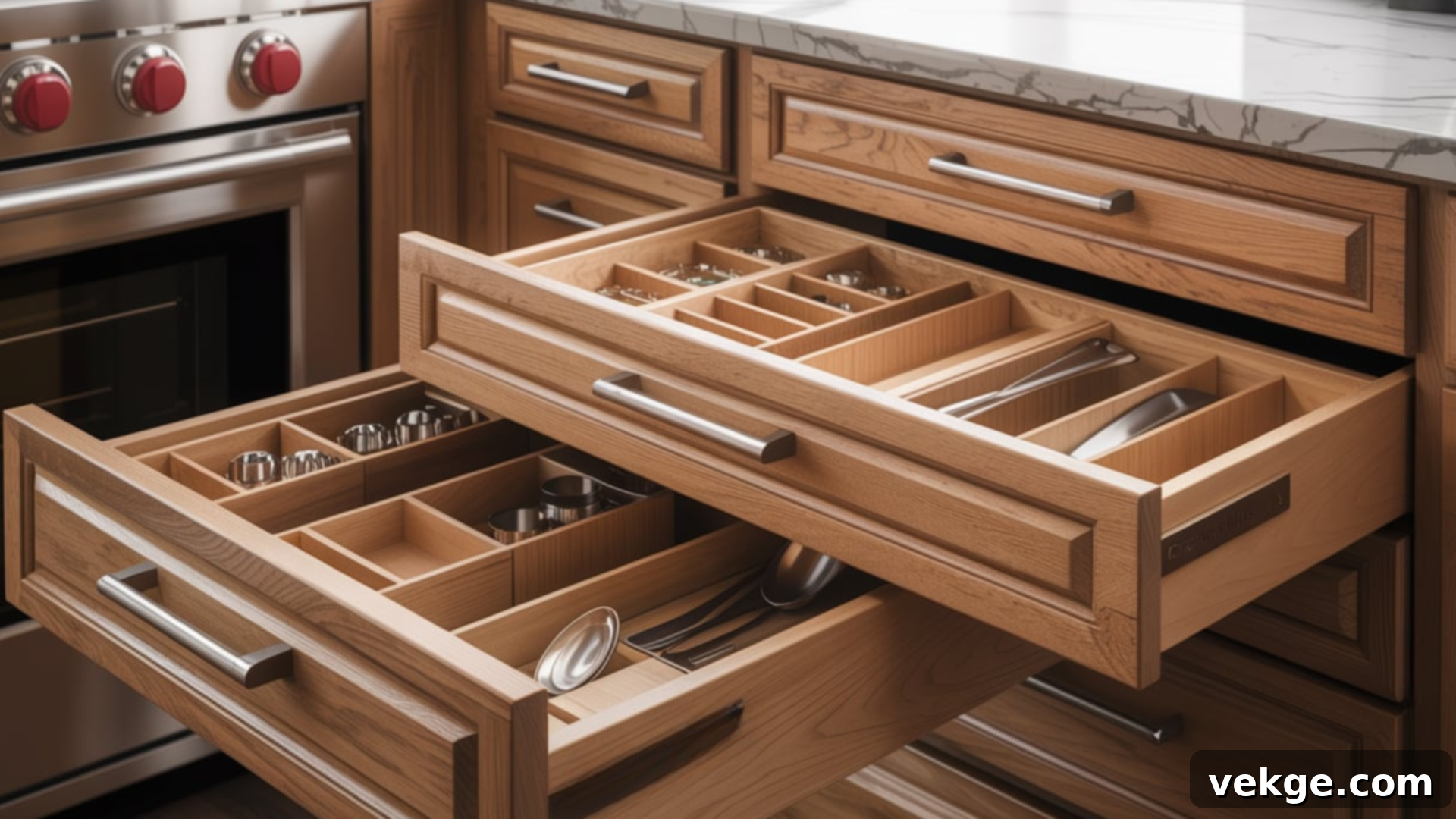
Invest in custom drawer systems that feature built-in organizers tailored for utensils, knives, spices, and more. These bespoke solutions ensure that every item has a dedicated place, making it easier to keep the kitchen tidy and efficient without the need for additional, bulky storage units. Custom systems perfectly align with the minimalist goal of hidden and highly functional organization.
28. Undermount Lighting
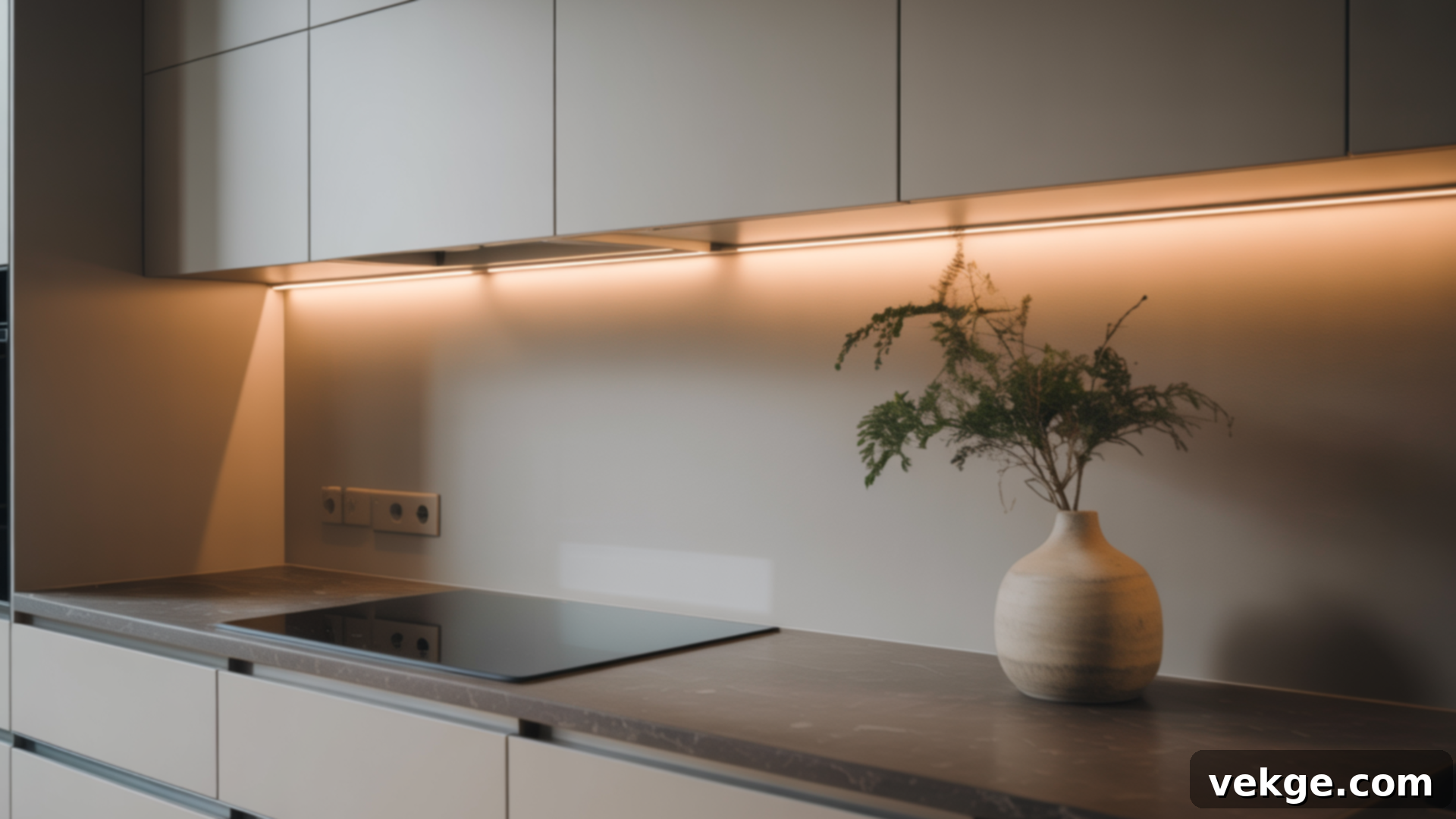
Install subtle undermount lighting beneath cabinets or shelves to effectively illuminate your workspace and enhance the kitchen’s ambiance. This soft, diffused light brightens countertops, improves task visibility, and contributes to the serene and sophisticated minimalist atmosphere. It adds a layer of practical luxury without introducing any visual clutter.
29. Natural Wood Accents
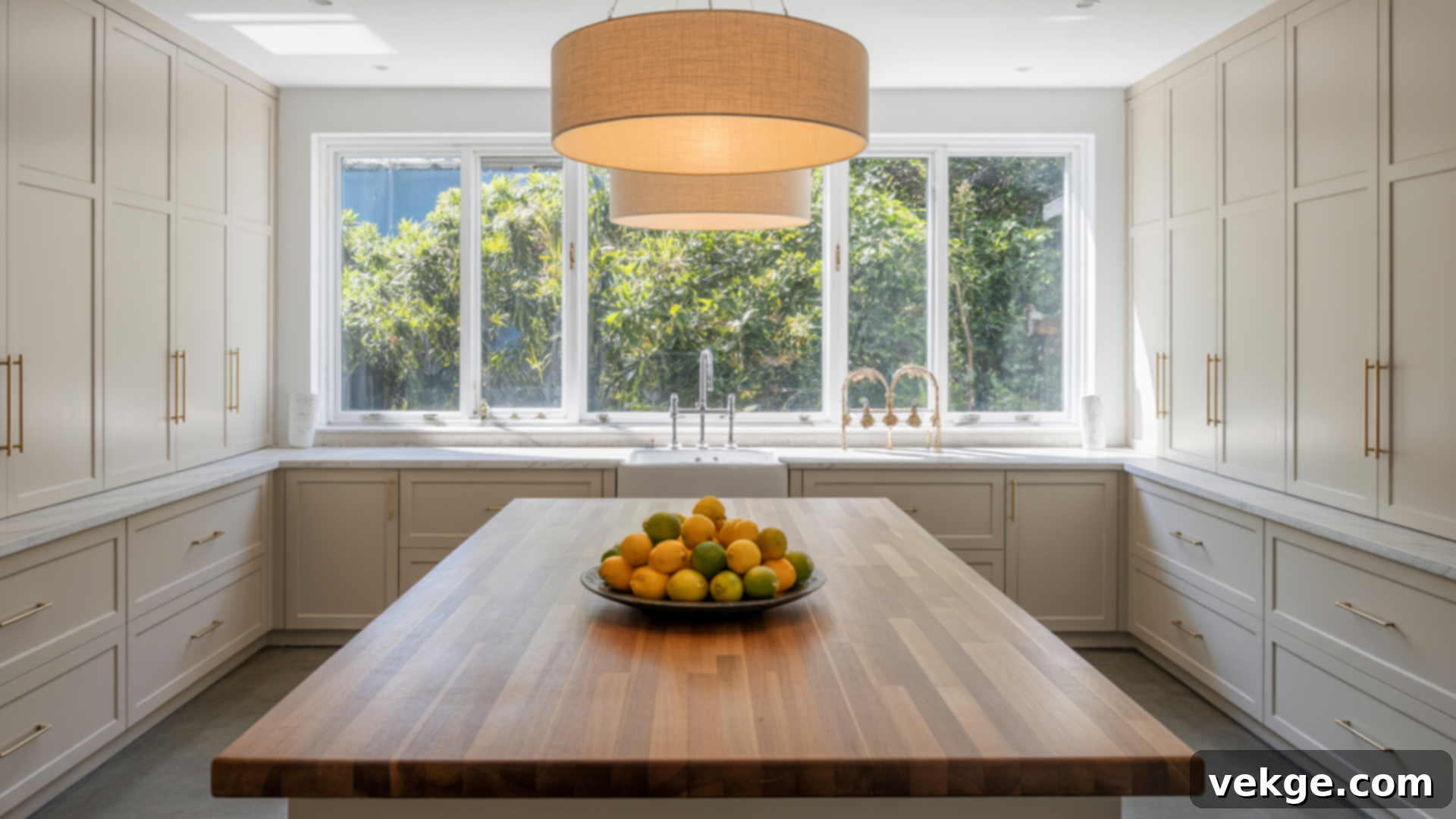
Introduce natural wood accents, such as a butcher block countertop, sleek wooden handles, or minimalist open shelves made of solid wood. Wood adds much-needed warmth, texture, and an organic element to an otherwise sleek and modern design. This approach beautifully balances the clean lines of minimalism with the inviting appeal of natural materials, creating a harmonious and grounded space.
30. Glass Backsplash
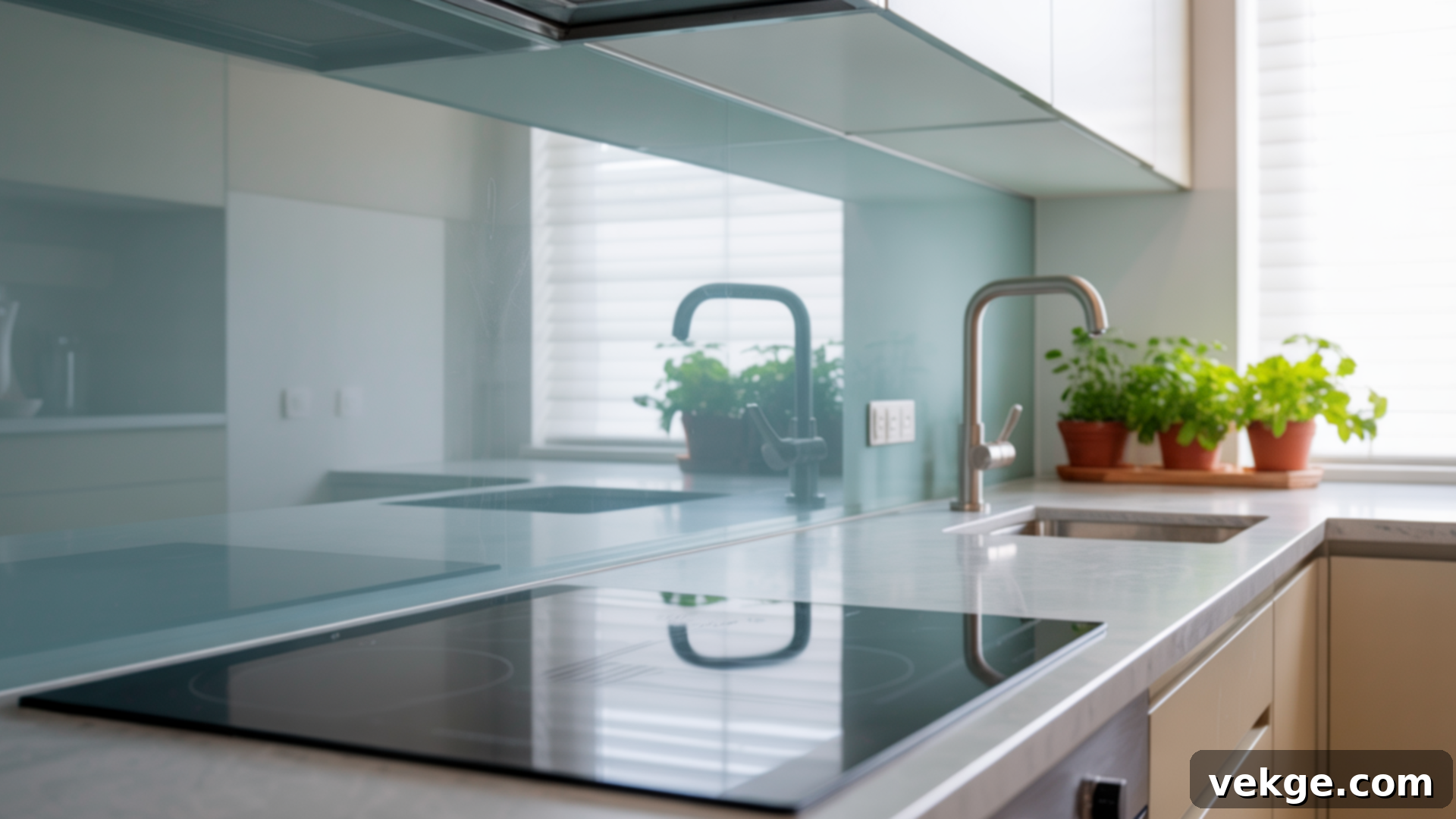
Opt for a smooth, transparent, or frosted glass backsplash to create a clean, contemporary look. Glass reflects light beautifully, contributing to a brighter and more expansive feel. It’s incredibly easy to clean, adds a touch of modern flair, and ensures the kitchen maintains a fresh and immaculate appearance, perfectly complementing the minimalist aesthetic.
31. Slim Profile Appliances
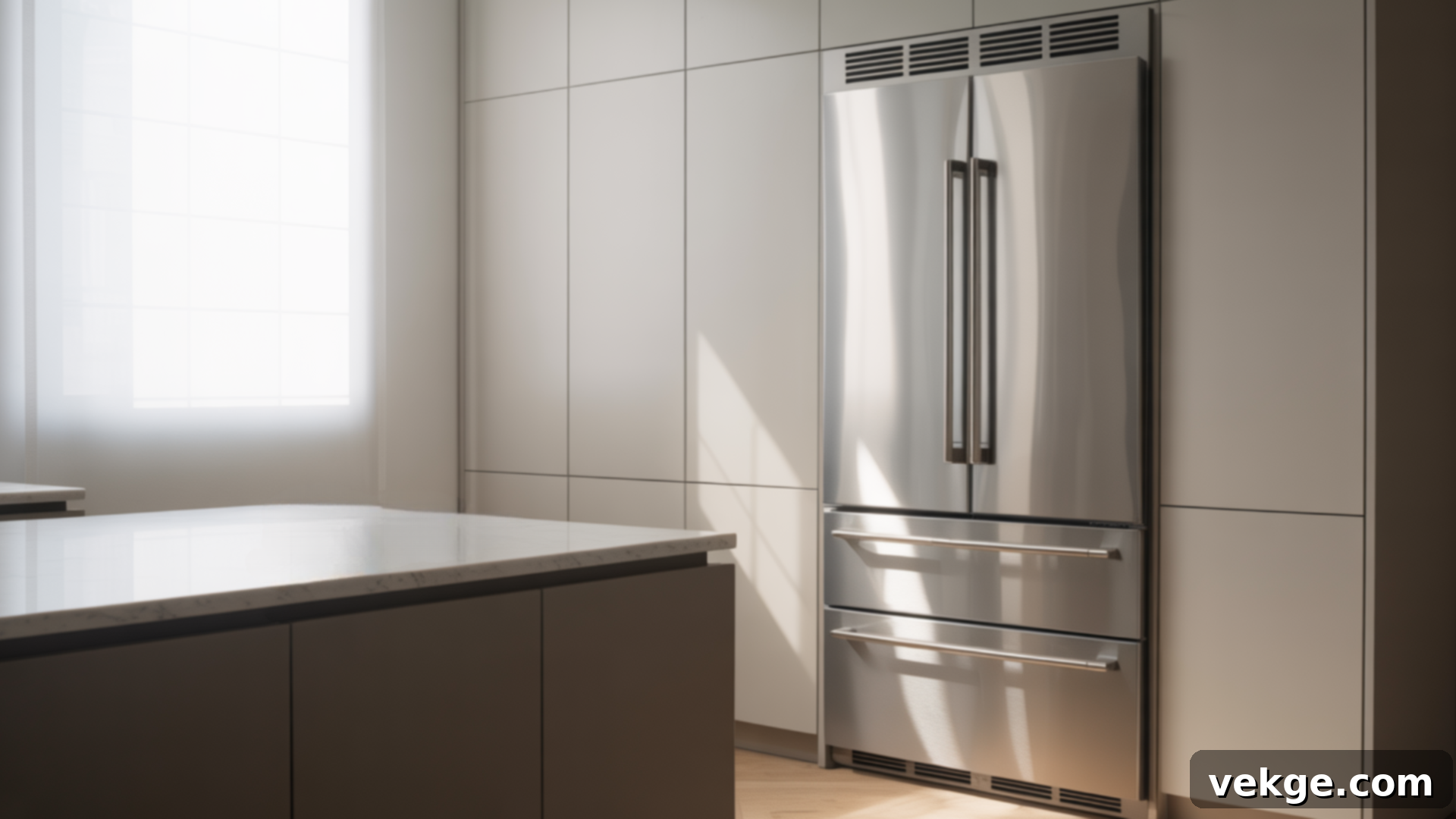
Select appliances with a slim, low-profile design to save space and integrate effortlessly into the kitchen’s aesthetic. Examples include narrow refrigerators, compact dishwashers, or sleek cooktops that sit flush with the counter. These choices take up less visual and physical space, making them ideal for minimalist kitchens where every inch and every visual element counts.
32. Open Floor Space

Prioritize an open layout with minimal furniture or accessories that obstruct movement. A spacious floor plan is fundamental to minimalist design, allowing for easy movement, enhancing the flow of light, and making the kitchen feel significantly larger, lighter, and airier. This creates an unencumbered and inviting environment.
33. Flush-Mounted Appliances

Choose appliances that are designed to be flush-mounted with your cabinetry, such as built-in refrigerators, dishwashers, or ovens. This creates a seamlessly integrated, built-in look that eliminates any protruding elements, making the kitchen feel more cohesive, streamlined, and organized. It’s a key element in achieving an uninterrupted, clean aesthetic.
34. Minimalist Window Treatments
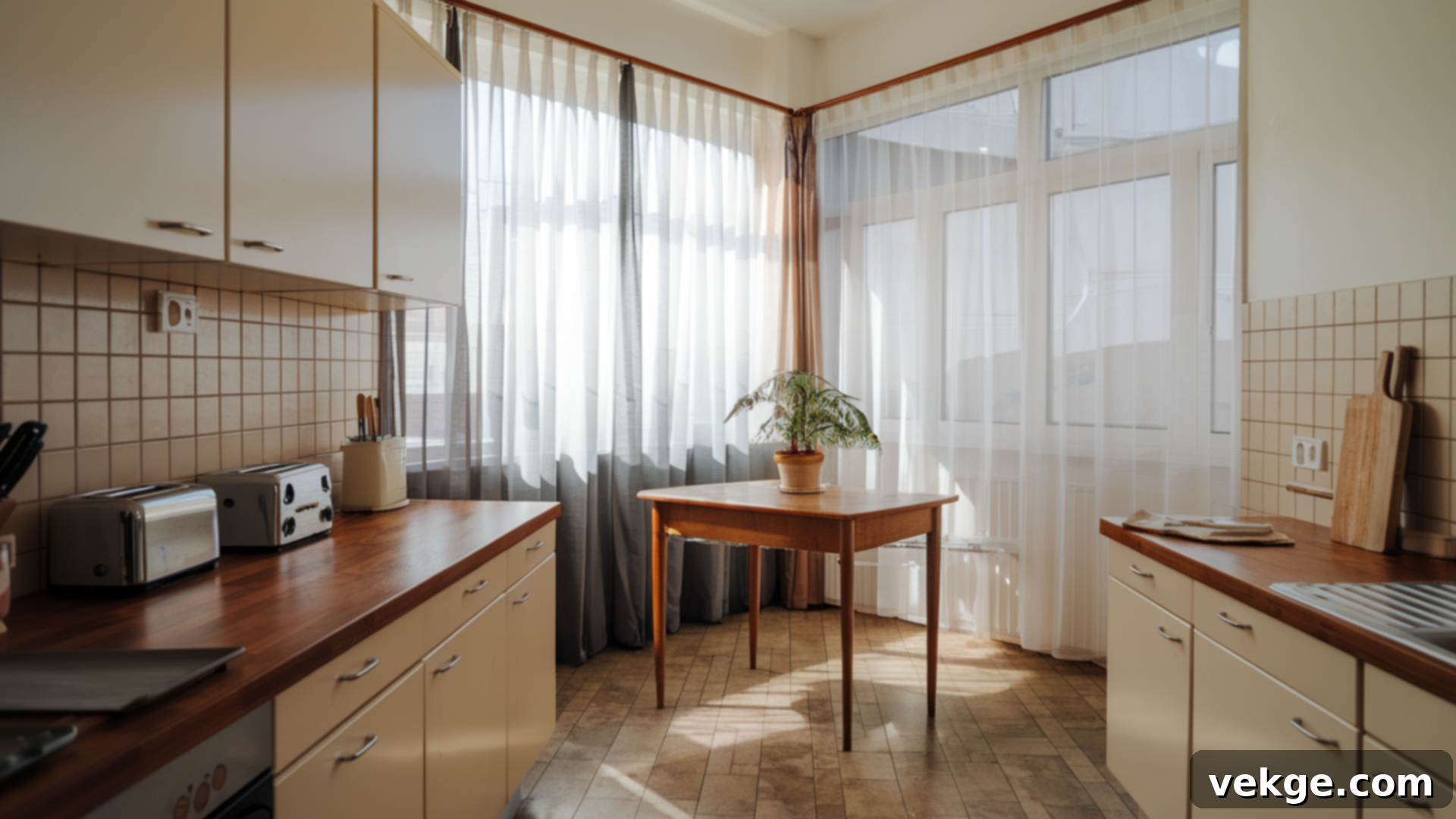
Select window treatments that are simple and unobtrusive, such as sheer roller blinds, discreet Venetian blinds, or even no treatments at all if privacy allows. The goal is to maximize natural light and maintain an airy feel without overpowering the space. Minimalist window treatments complement the kitchen’s streamlined design, ensuring uninterrupted views and abundant brightness.
35. Simple Glass Storage Jars
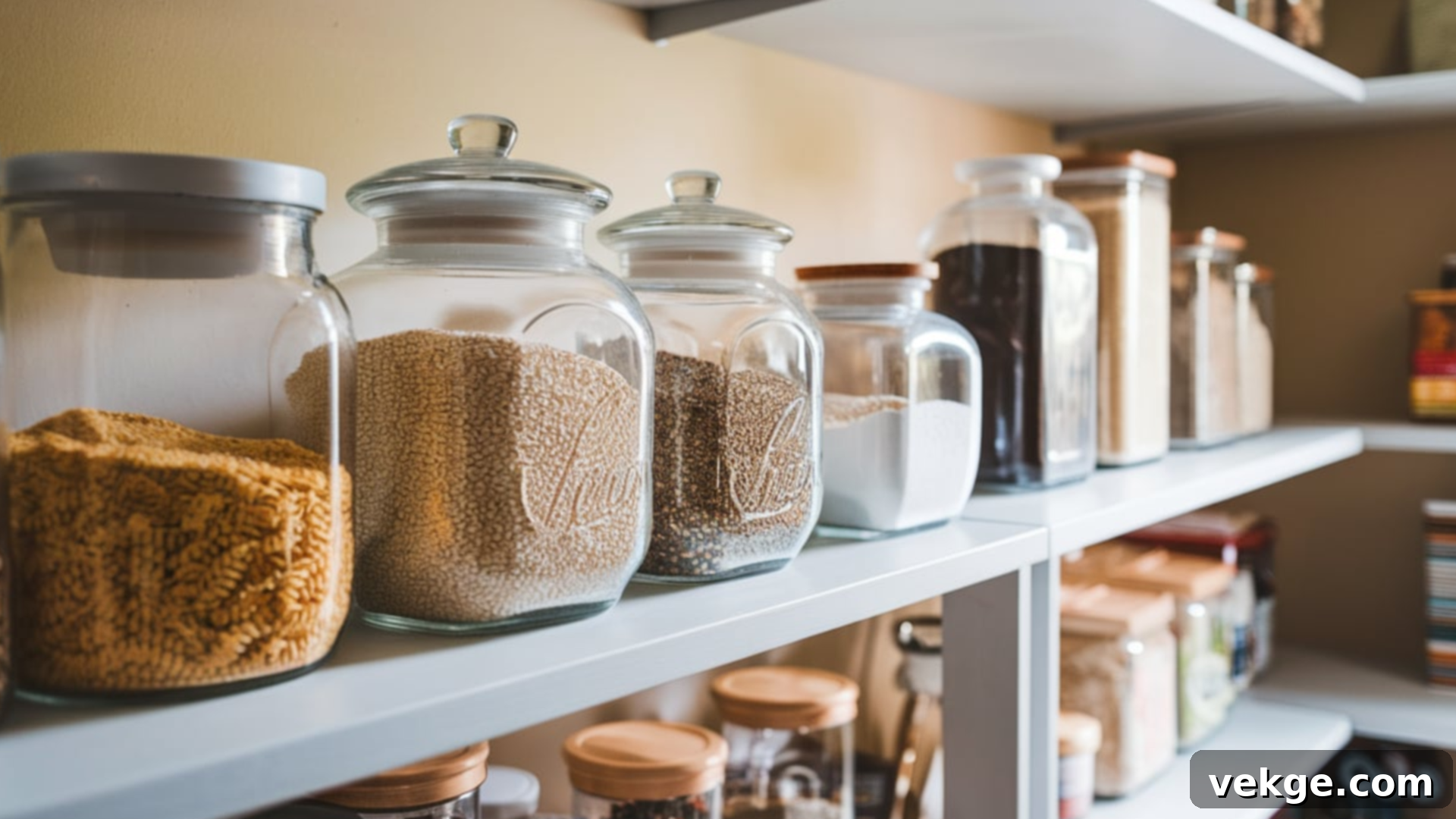
Organize pantry essentials and visible dry goods using simple, uniform glass storage jars with minimalist labels. This functional and aesthetic choice adds a clean, harmonious look to open shelving or pantries, reducing visual clutter from mismatched packaging. It complements the minimalist design by providing an organized and visually appealing storage solution.
36. Open Floor Plan (Continued)
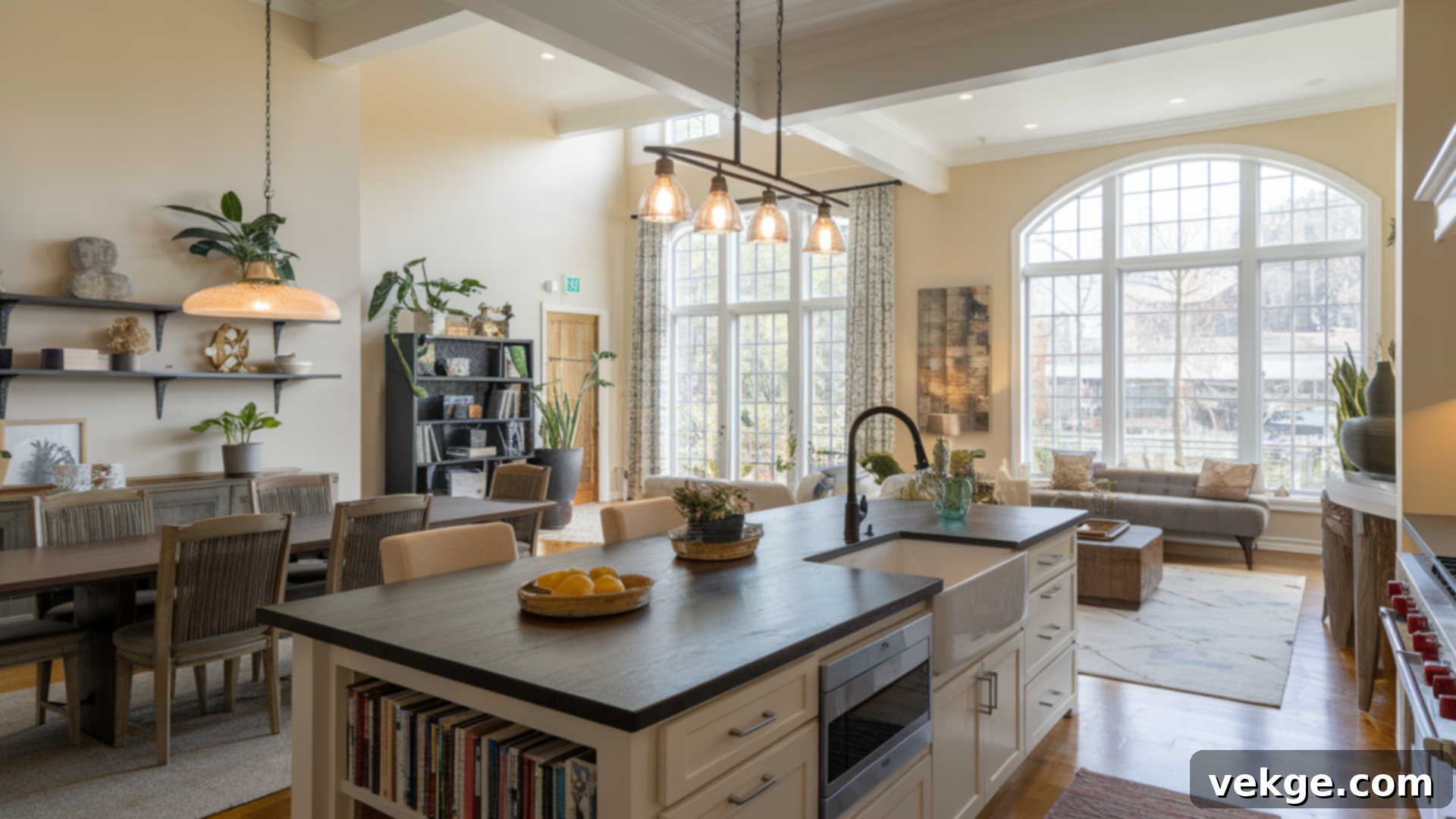
Reiterating the importance of an open floor plan, ensure your kitchen integrates seamlessly with adjacent dining or living areas. This design concept fosters a strong sense of space and natural flow throughout your home, preventing any area from feeling isolated. It reinforces the minimalist principle of cohesion and spaciousness, making the entire living area feel more expansive and connected.
37. Hidden Refrigerator
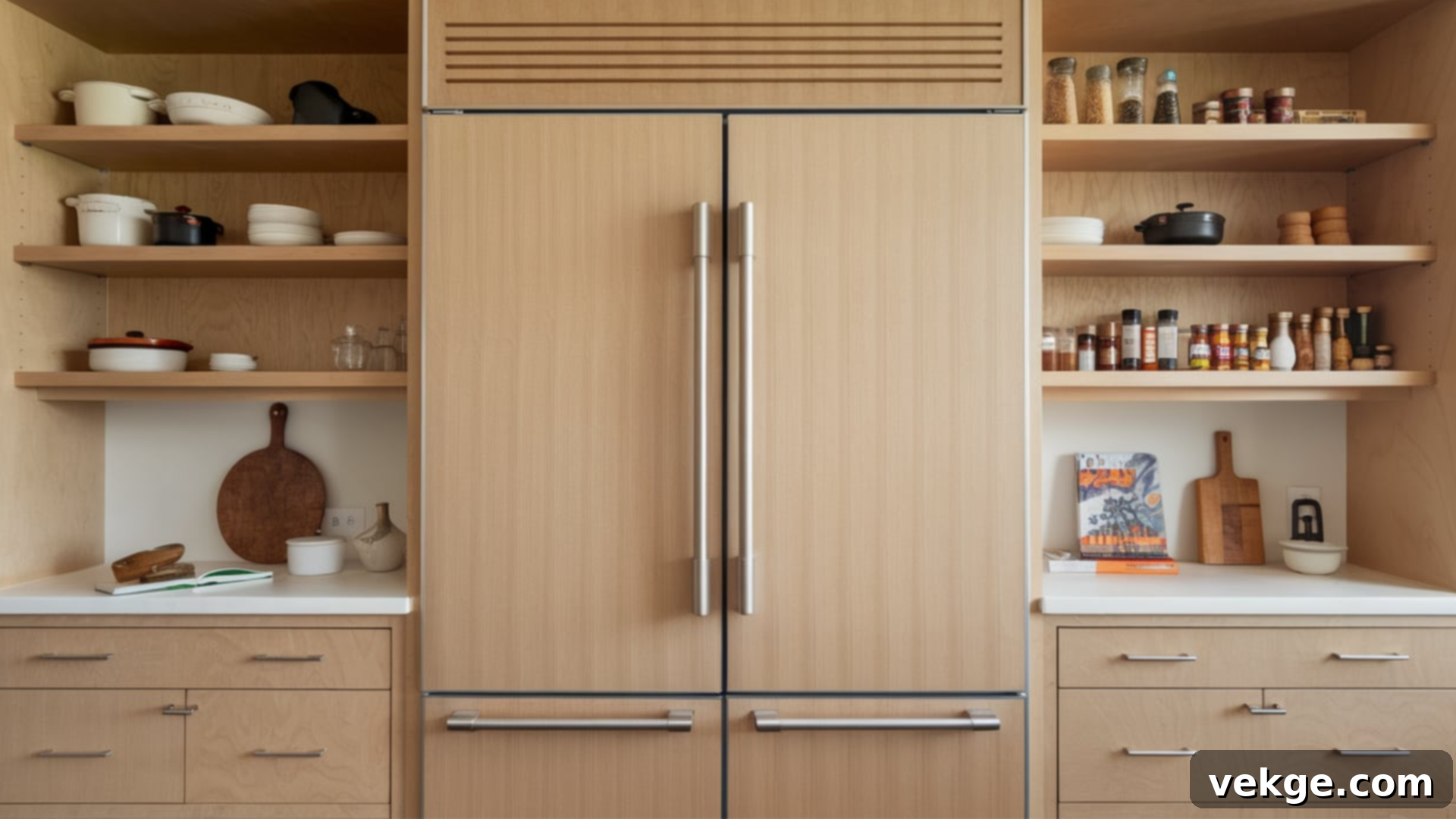
For the ultimate minimalist look, integrate your refrigerator into custom cabinetry with a flush finish, allowing it to completely disappear into the kitchen’s design. This creates a clean, uninterrupted wall of cabinetry, eliminating the visual bulk of a traditional appliance. It offers full functionality while maintaining a perfectly streamlined and discreet aesthetic.
38. Neutral-Toned Countertop
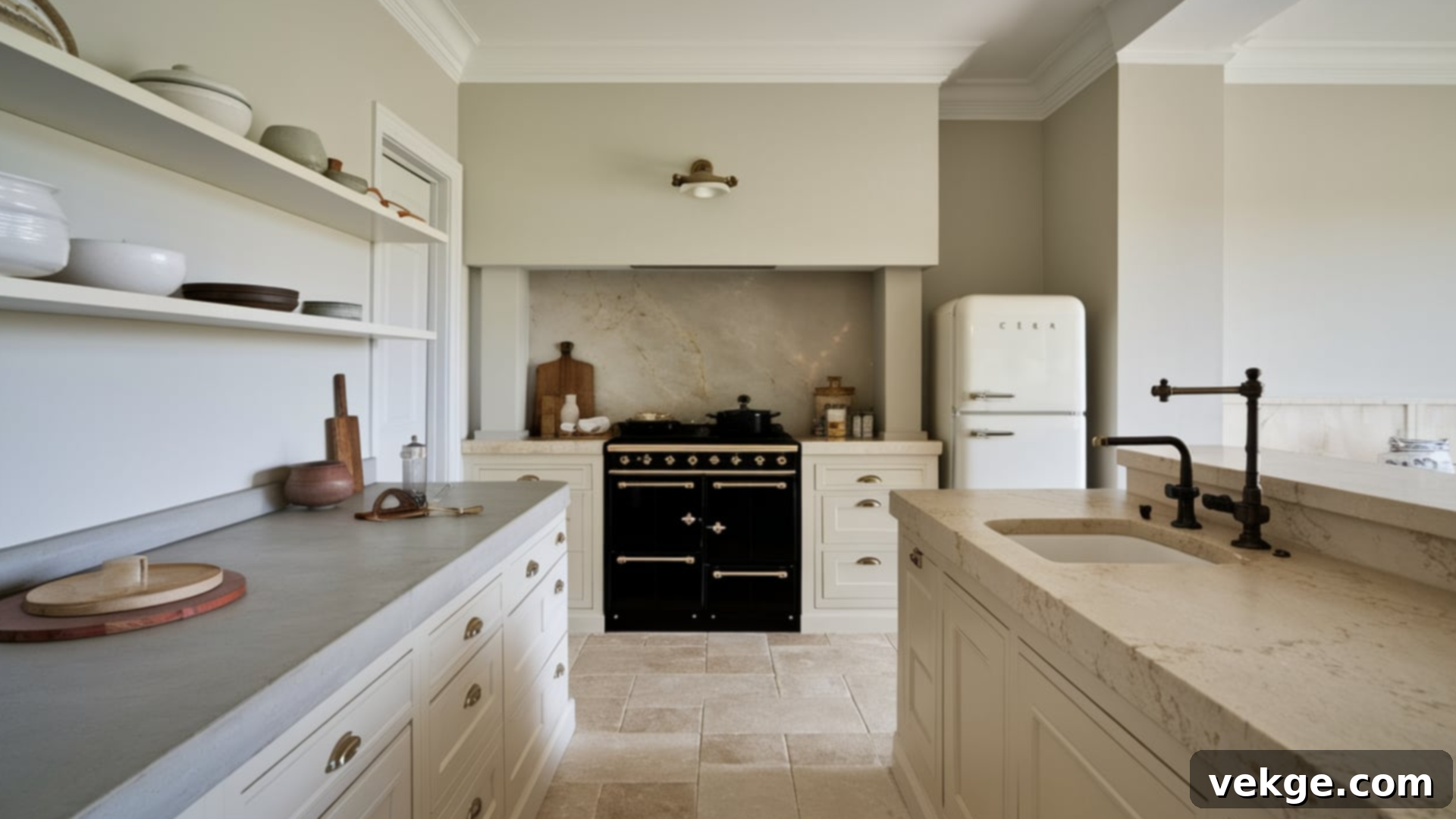
Select countertops made from neutral-toned materials such as sleek concrete, pristine white marble, or durable quartz. These surfaces inherently blend into the minimalist design, providing a balanced and clean appearance that complements any cabinet choice. Such materials are not only visually appealing but also offer resilience and easy maintenance, key factors in a functional minimalist kitchen.
39. Pocket Doors for Cabinets
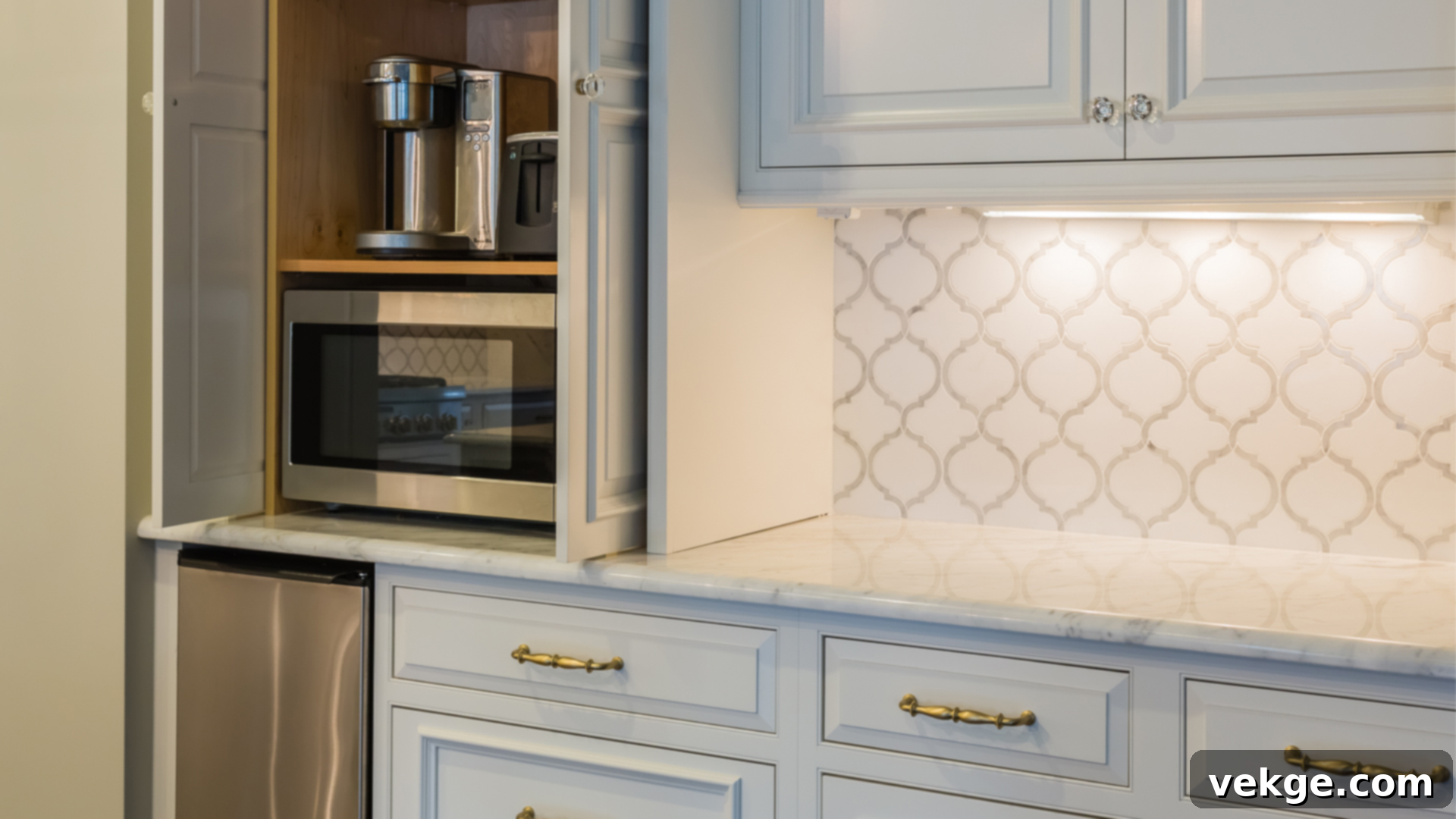
Install pocket doors for cabinetry, which slide smoothly into the wall when opened, completely disappearing from view. This ingenious space-saving feature keeps your kitchen looking consistently tidy and uncluttered, especially when cabinets are frequently accessed. It offers effortless access to stored items while maintaining a sleek, uninterrupted wall of cabinetry.
40. Built-In Herb Garden
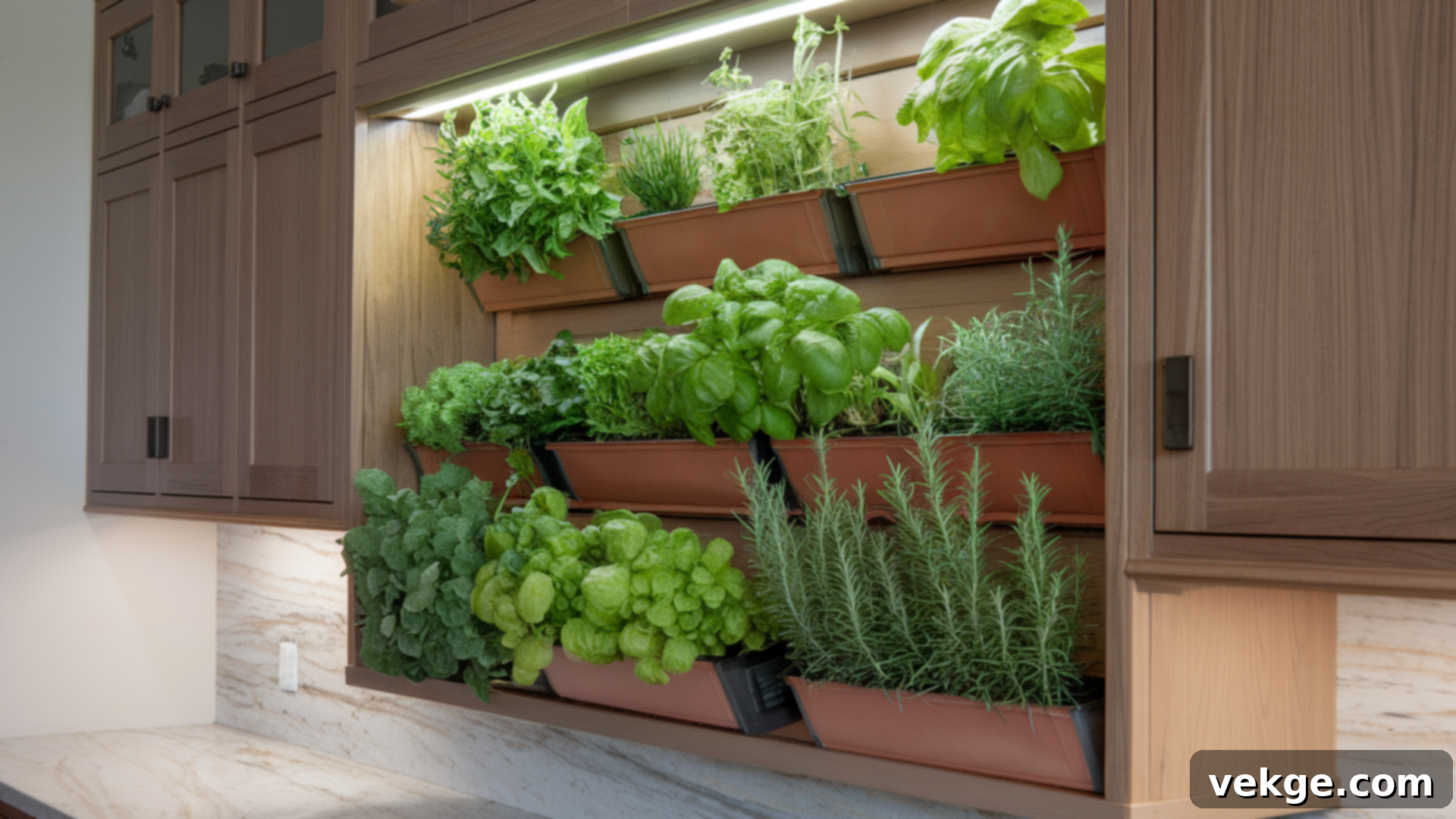
Integrate a compact, built-in vertical herb garden into a wall or cabinetry for a fresh supply of herbs. This addition not only enhances your cooking experience with readily available ingredients but also brings a touch of vibrant greenery and life to the kitchen. When thoughtfully designed, it becomes a seamless and beautiful feature that complements rather than disrupts the minimalist aesthetic.
41. Hidden Induction Cooktop
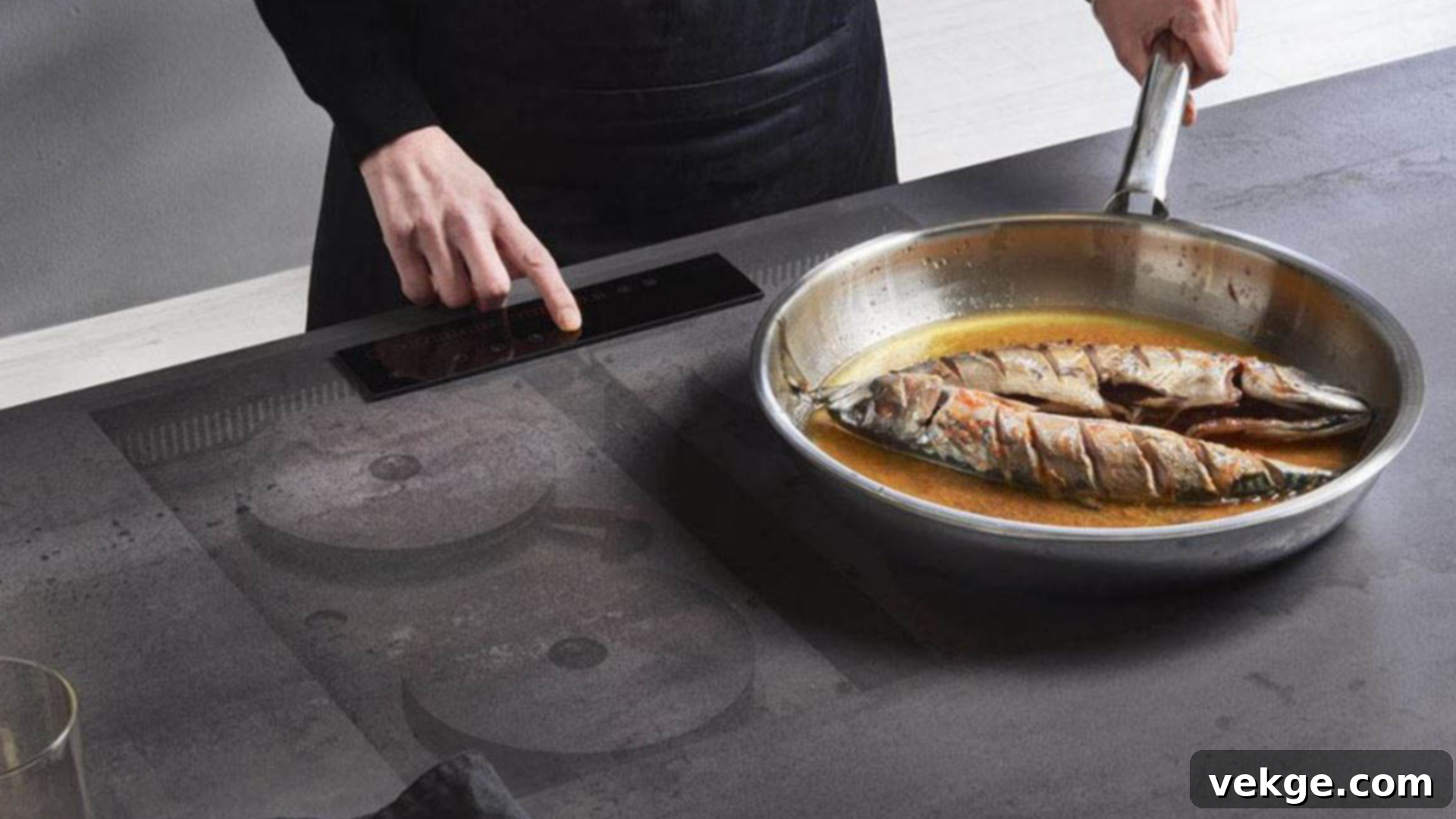
For the ultimate clean look, consider a hidden induction cooktop that is integrated directly into the countertop. When not in use, it can be covered with a matching countertop piece, creating a fully uninterrupted and smooth surface. This innovative solution allows for maximum flexibility and a truly minimalist design, making the kitchen look completely seamless when cooking isn’t needed.
42. Magnetic Knife Rack
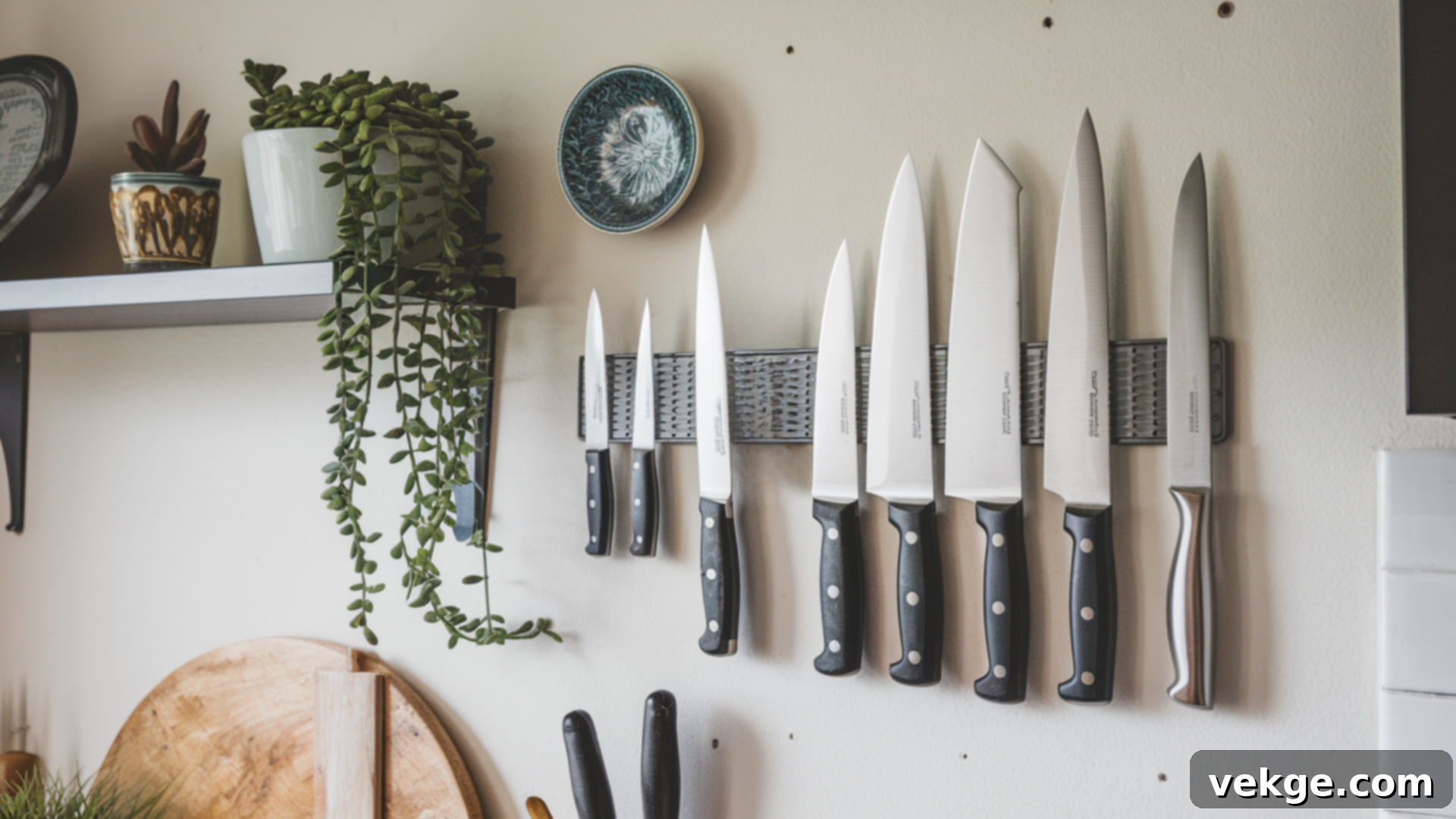
Install a sleek, wall-mounted magnetic strip to securely store knives, eliminating the need for bulky and often space-consuming knife blocks on the counter. This minimalist storage solution keeps knives accessible and neatly organized while significantly freeing up valuable counter space. It’s a practical, hygienic, and aesthetically pleasing choice for a modern, clutter-free kitchen.
Sustainability in a Minimalist Kitchen
A minimalist kitchen naturally aligns with the principles of sustainability, creating an eco-friendly and responsible cooking space. The philosophy of “less is more” directly translates to reducing waste, conserving resources, and making conscious choices that benefit the planet. Here’s how to integrate sustainability into your minimalist kitchen design and lifestyle:
- Choose Durable and Eco-Friendly Materials: Start by selecting long-lasting and sustainably sourced materials for your countertops, cabinetry, and flooring. Opt for options like recycled wood, bamboo, cork, or responsibly harvested hardwoods. These materials not only stand the test of time but also reduce your environmental footprint compared to conventional choices.
- Invest in Energy-Efficient Appliances: Minimize your energy consumption and utility bills by choosing appliances with high Energy Star ratings. Induction cooktops, efficient refrigerators, and dishwashers are designed to consume less power, contributing significantly to a greener home. Their sleek, integrated designs often also align perfectly with minimalist aesthetics.
- Reduce Single-Use Plastics: A key aspect of sustainability is minimizing disposable items. Transition to reusable storage containers made of glass or stainless steel, invest in cloth napkins instead of paper towels, and use refillable soap dispensers. These small changes drastically cut down on plastic waste and promote a more mindful approach to consumption.
- Embrace Mindful Shopping and Reduce Food Waste: A minimalist kitchen encourages you to buy only what you truly need, reducing impulse purchases and food waste. Plan your meals, shop with a list, and utilize clever storage solutions to keep food fresh longer. Composting food scraps further closes the loop, turning waste into valuable soil enrichment.
- Support Local and Organic Food Sources: Prioritize sourcing your food from local farmers’ markets and choosing organic options whenever possible. This not only supports sustainable farming practices but also reduces the carbon footprint associated with long-distance transportation, bringing fresher, healthier ingredients to your minimalist table.
By simplifying your kitchen and making these sustainable choices, you not only create a calm, clutter-free, and beautiful environment but also contribute positively to the health of our planet, aligning your home with your values.
Optimising Minimalism in Small or Large Kitchens
Regardless of your kitchen’s size, the core principles of minimalism can be effectively applied to optimize both space and functionality. Whether you’re working with a cozy, compact area or a sprawling, spacious kitchen, the key remains a steadfast focus on simplicity, efficiency, and thoughtful design. Here’s how you can tailor minimalist strategies to kitchens of different scales:
| Aspect | Small Minimalist Kitchen | Large Minimalist Kitchen |
|---|---|---|
| Storage Solutions | Maximize every inch with vertical storage (floor-to-ceiling cabinets, floating shelves), pull-out pantries, and multi-tier drawer organizers. Think hidden and compact. | Leverage ample space with built-in appliances, deep drawers, walk-in pantries, and specialized cabinets for various zones. Focus on expansive, seamless concealment. |
| Furniture | Opt for multifunctional furniture such as extendable tables, storage benches, or mobile islands that can be tucked away or serve multiple purposes. | Integrate larger, statement furniture with multiple functions, like a grand kitchen island with seating, storage, and even a built-in wine cooler. |
| Countertop Space | Essential to keep surfaces completely clear. Use wall-mounted accessories or hidden charging stations to maximize every precious inch for food preparation. | While abundant, still maintain uncluttered surfaces. Use large, simple decorative elements sparingly and focus on wide-open spaces for a luxurious feel. |
| Lighting | Utilize bright, functional task lighting (under-cabinet lighting) and compact overhead fixtures. Maximize natural light with minimal window treatments. | Implement recessed lighting throughout, larger pendant lights over an island, and strategic under-cabinet strips to illuminate specific zones and enhance ambiance. |
| Space Planning | Focus on making the most of every inch with compact designs and a highly efficient workflow triangle. Ensure clear pathways for easy movement. | Emphasize expansive flow, clean lines, and distinct zones for cooking, prep, and dining. Design for an open, airy, and inviting feel with purposeful separation. |
| Appliances | Choose compact, multi-functional appliances (e.g., all-in-one blenders, convection microwave ovens) and integrate them into cabinetry to save space. | Opt for full-sized, high-end appliances that are fully integrated into cabinetry, featuring sleek, minimalist designs that blend seamlessly with the overall aesthetic. |
| Overall Feel | Use light colors, reflective surfaces, and strategic open shelving to create a strong sense of space and prevent a cramped feeling. Maintain brightness and simplicity. | Focus on maintaining an open, airy, and sophisticated feel with elegant, streamlined designs. Let the quality of materials and spaciousness define the aesthetic. |
By thoughtfully applying these considerations, anyone can achieve a beautifully minimalist kitchen that is perfectly scaled and optimized for their specific space, promoting efficiency and calm.
Common Mistakes to Avoid in a Minimalist Kitchen
While the goal of a minimalist kitchen is clear—simplicity and functionality—it’s surprisingly easy to fall into traps that undermine these very aims. When designing your serene cooking space, be mindful of these common pitfalls to ensure your minimalist kitchen is as practical as it is beautiful:
- Focusing Too Much on Appearance, Neglecting Functionality: It’s tempting to prioritize the sleek, clean aesthetic above all else. However, if your minimalist choices make basic kitchen tasks awkward or inefficient, you’ve missed the point. Ensure every design decision, from cabinet placement to appliance choice, enhances rather than hinders your workflow.
- Keeping Unnecessary Items That Don’t Serve a Clear Purpose: Minimalism isn’t just about hiding clutter; it’s about eliminating it. Don’t simply tuck away items you rarely use or don’t truly need. Regularly declutter your kitchen, keeping only essentials that genuinely serve a purpose or bring you joy.
- Failing to Incorporate Efficient Storage Solutions: A minimalist kitchen thrives on invisible storage. A common mistake is not planning enough smart, hidden storage, leading to items inevitably creeping back onto countertops. Invest in custom drawers, pull-out pantries, and integrated solutions to keep everything neatly out of sight.
- Designing a Layout That Disrupts the Cooking Workflow: The “workflow triangle” (sink, refrigerator, stove) is crucial for efficiency. An overly minimalist design that separates these elements too much, or places essential prep areas far from the sink, can make cooking a chore rather than a pleasure. Prioritize a logical, ergonomic layout.
- Overlooking the Importance of Proper Lighting: While natural light is paramount, neglecting artificial lighting can make a minimalist kitchen feel cold or unwelcoming in the evenings. Ensure you have a balanced lighting plan, including task lighting for prep areas, ambient lighting for overall illumination, and accent lighting to add warmth and depth.
- Choosing Impractical Materials: Some minimalist materials, while beautiful, can be impractical for a high-traffic area like a kitchen. For instance, highly porous countertops or delicate finishes may stain or scratch easily, requiring constant maintenance that contradicts the easy-living aspect of minimalism. Opt for durable, low-maintenance materials that stand up to daily use.
By being aware of these common mistakes, you can design a minimalist kitchen that perfectly balances sophisticated style with unparalleled practicality, ensuring it truly enhances your daily life.
Conclusion
Embarking on the journey to simplify your kitchen is a transformative experience, as I’ve found firsthand. It’s not merely about tidying up; it’s about crafting a space that truly supports your well-being, fostering practicality, peace, and a renewed joy in cooking and gathering. By focusing on efficiency, thoughtful organization, and purposeful design, my kitchen has become a haven where daily tasks feel effortless and enjoyable.
I wholeheartedly recommend beginning with small, manageable changes. Start by decluttering your countertops, making a conscious effort to store items out of sight, or selecting a few versatile kitchen tools that can replace multiple single-use gadgets. Remember, the essence of a minimalist kitchen isn’t about achieving unattainable perfection; it’s about continuously refining your space to better serve you and your lifestyle. It’s an ongoing process of intentional choices that lead to a more functional, beautiful, and serene home.
If you’re seeking further inspiration or practical tips on how to cultivate your own minimalist kitchen oasis, I encourage you to explore other resources and blogs. Let your journey be guided by simplicity, purpose, and the creation of a kitchen that truly elevates your everyday living!
